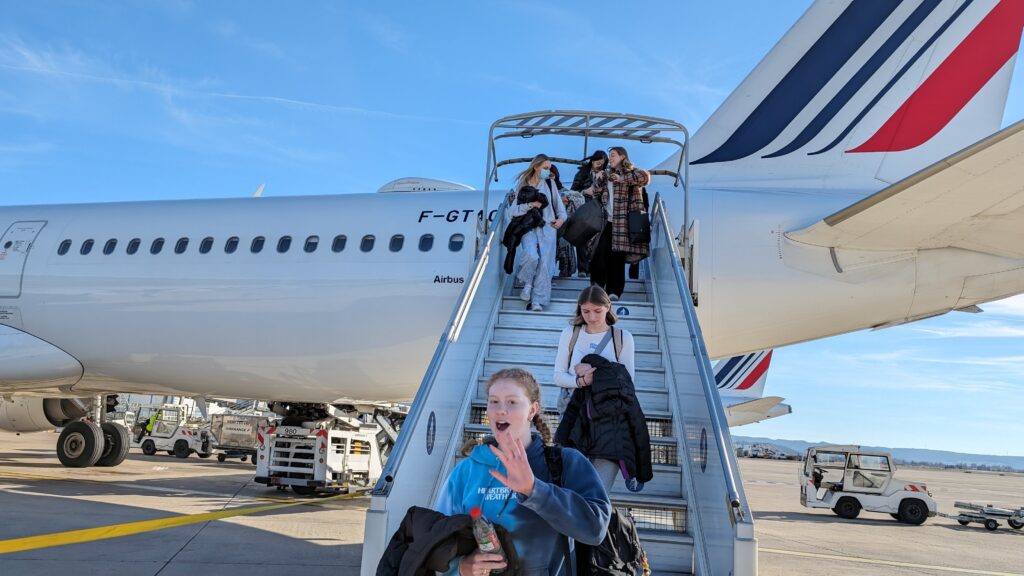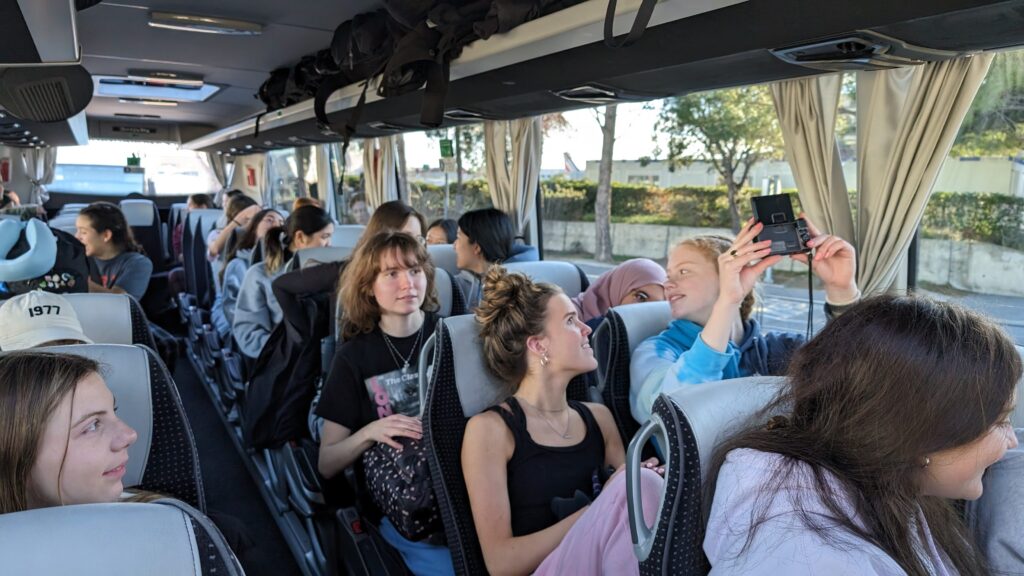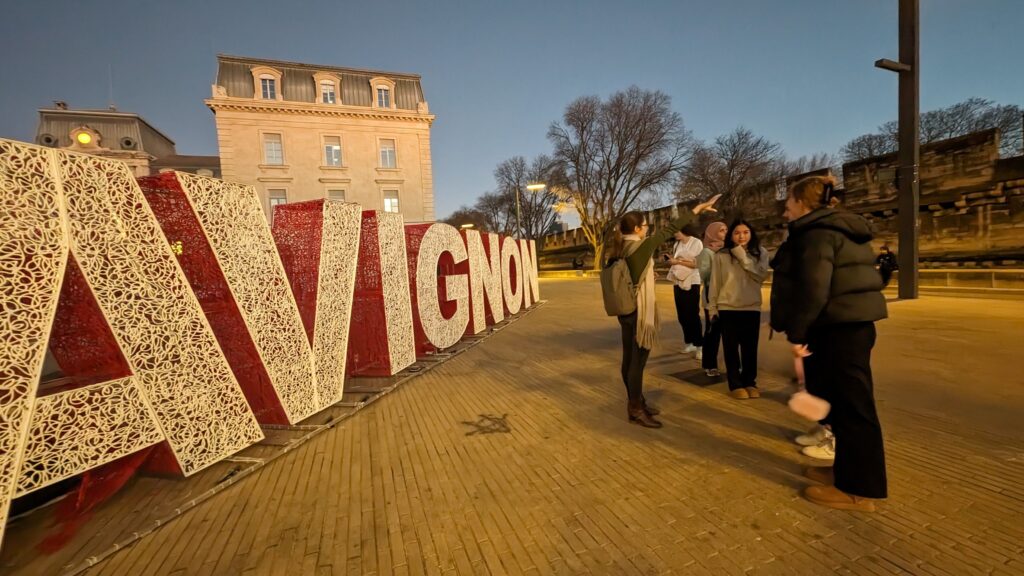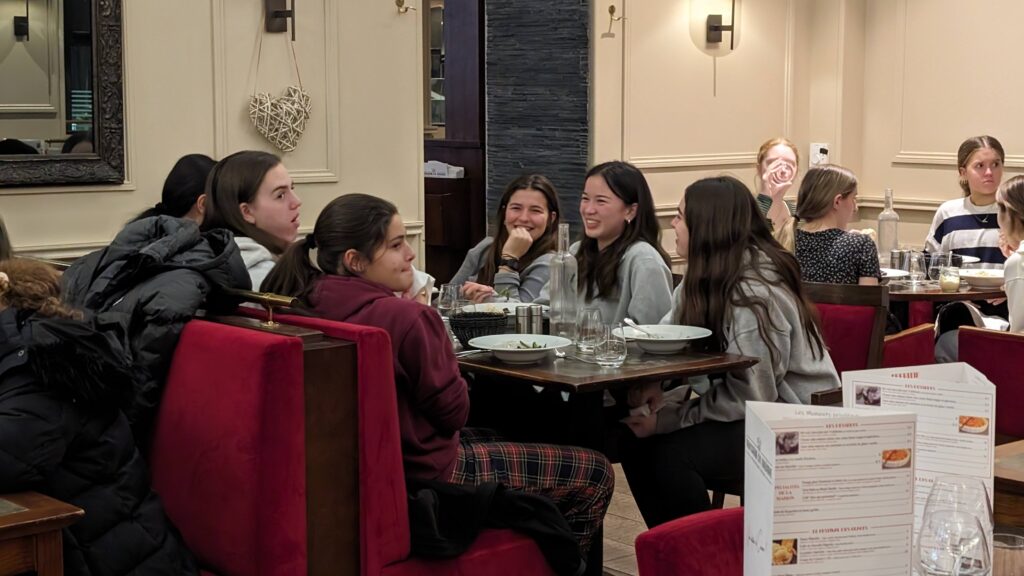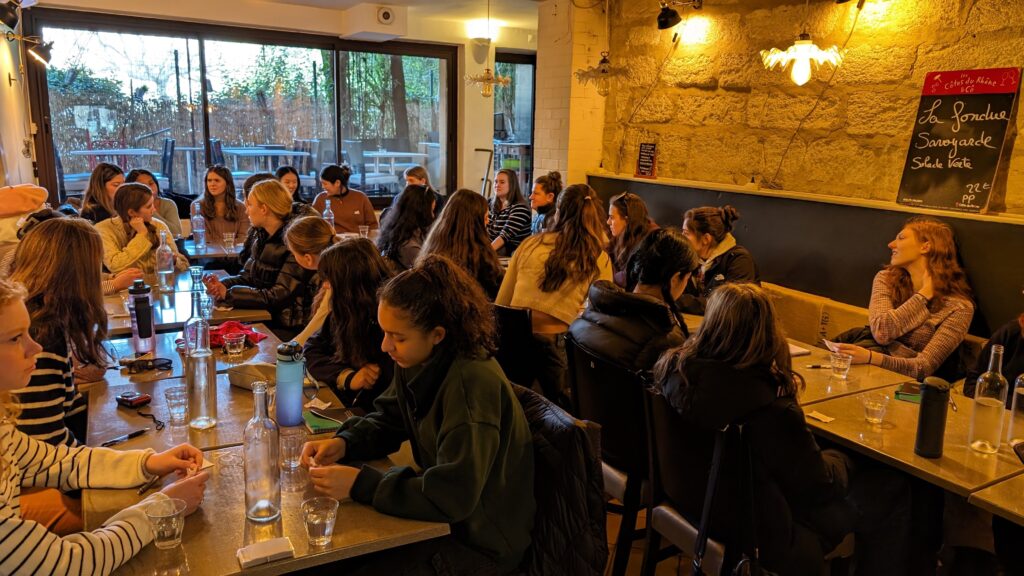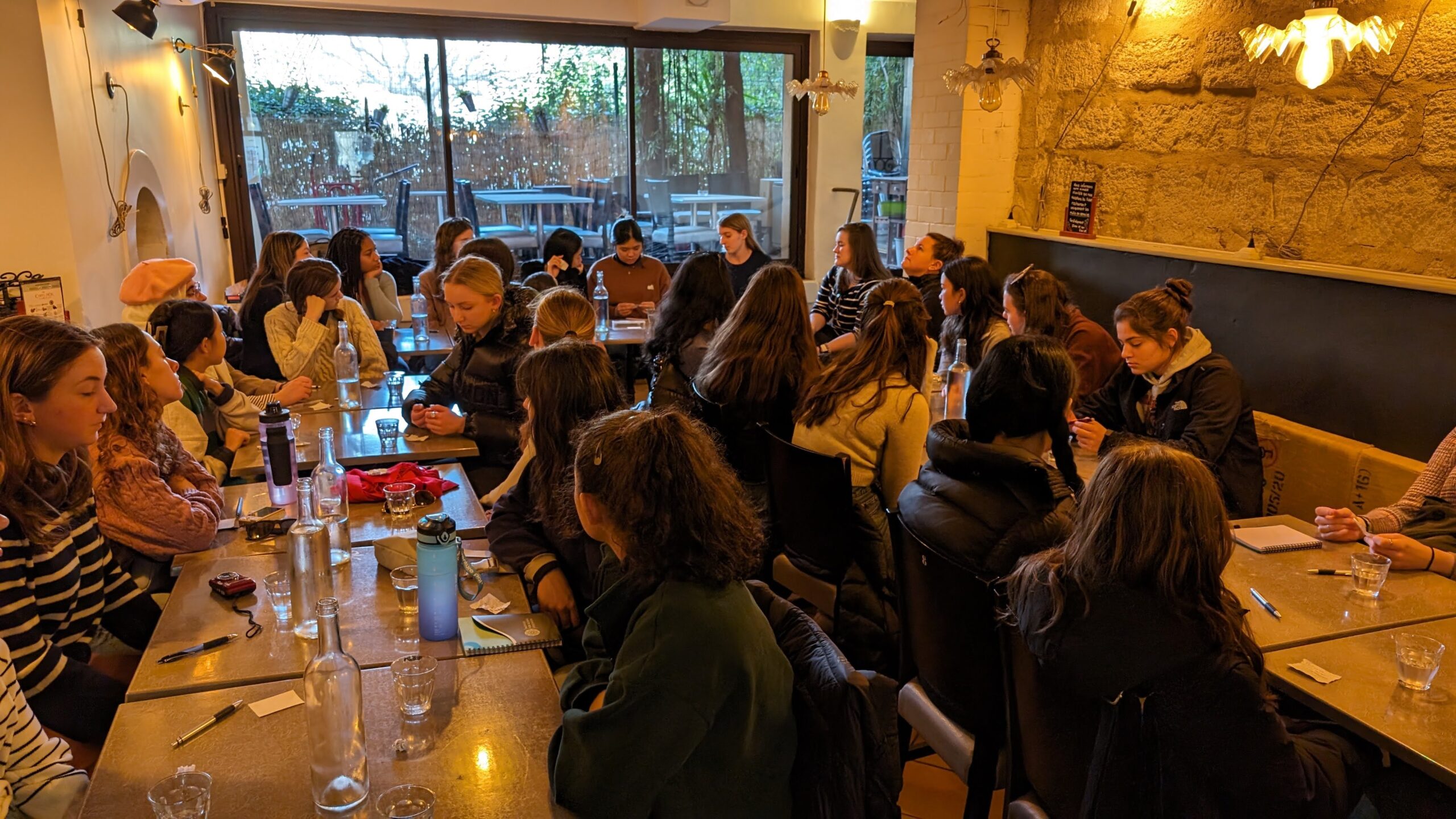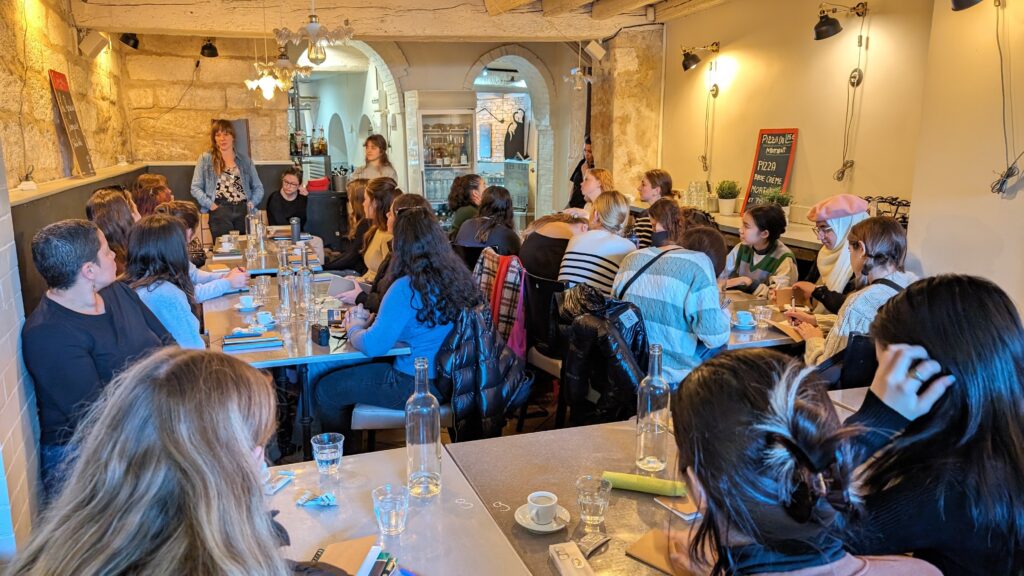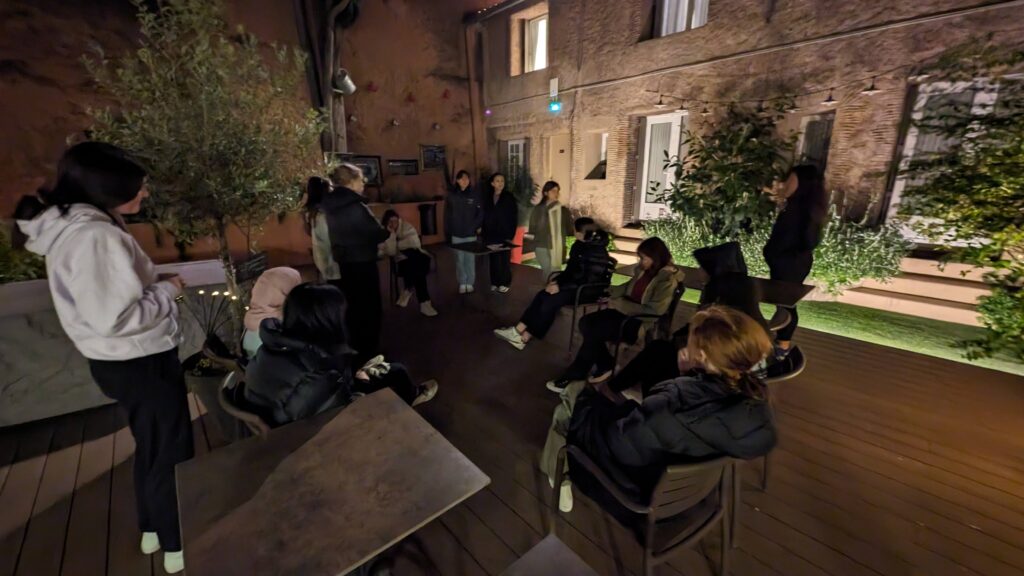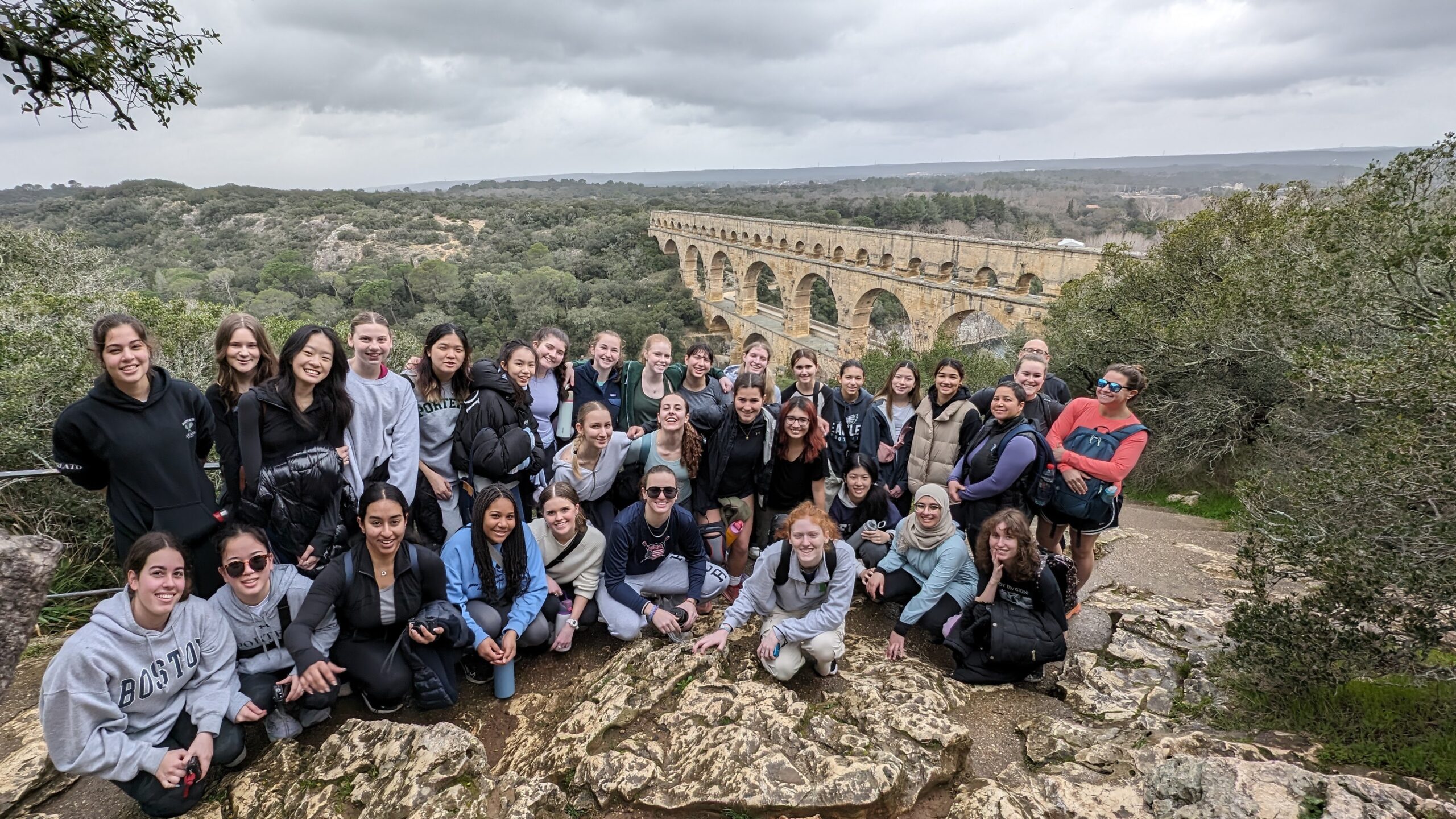Students will spend over a week in Avignon, France studying the development of ancient, medieval and modern cities and learning about their role as political, economic and cultural centers. Some key themes explored will be the intersection of physical spaces and cultural values, the tension between individual and collective needs, and the often conflicting goals of different stakeholders, past, present, and future, in an urban community. We will “zoom in” on historical artifacts, monuments, and architecture to examine whose stories they tell and consider how present and future populations will continue to inscribe traces of their presence over their lifetimes. We will “zoom out” to examine how cities embrace their legacies, face their dysfunction, and strive to balance preservation with development.
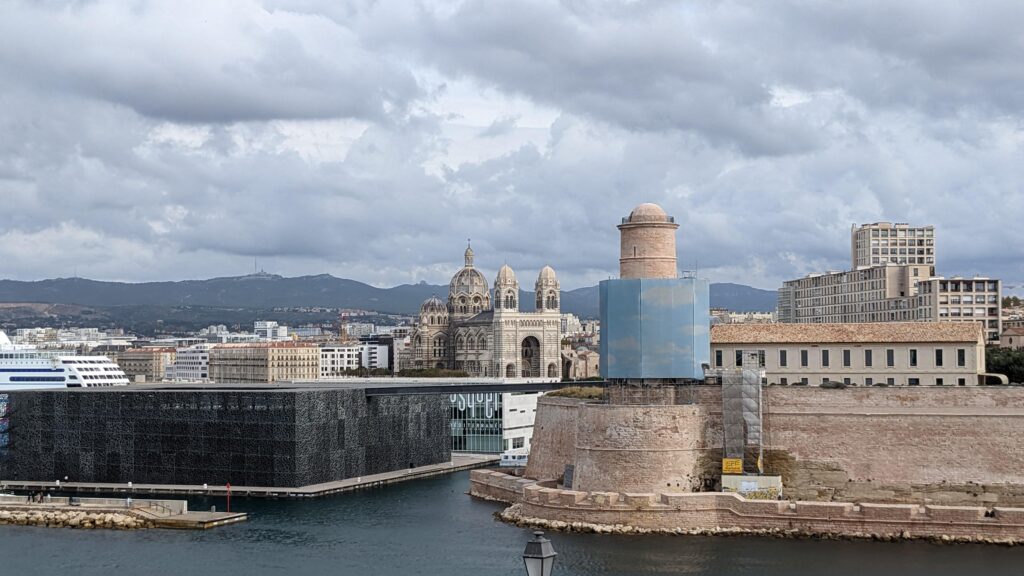
The students will use the small medieval city of Avignon as one of the study models and also the larger city of Marseille. The students will meet with local entrepreneurs, city officials and urban designers and visit other urban areas and points of interest in the area to get a 360 view of the place and learn about the region and how it became what it is today.
February 14
Student Author: Meredith L.
Waking up, there was not much on the agenda. It was really a day for packing, last minute shopping, and taking a last look at Avignon, a place we have grown to love in the last two weeks. In the afternoon we all came back together as a large group to present what was deemed “a mini demonstration of learning”. This was a time to lay out our understandings and takeaways from all the lovely places we got to visit. There were debates over the preservation of Avignon and Marseille, and whether one city was more effective than the other. Presentations about food and its impact culturally, as well as how culture can be impacted or influenced by geographical location. Overall, the “mini demonstrations of learning” highlighted all the best parts of our experiences.
Dinner was the next big thing of the day with the whole group making our way over to Grand Café Barretta for a delicious meal. Truly, the dinner was a wonderful time of reflection over the time we have had in France. Our tables were filled with joyful chatter and laughter as we shared our favorite memories from the trip.
When sitting with everyone at dinner I thought back to all the unique and once in a lifetime experiences I had in only two weeks. I learned not only about Avignon, Arles, Aix, Marseille and Provence as a whole, but also about myself.
With all the tours, I learned about French culture and the lengths they go to preserve it. We visited a number of churches, palais, and monuments which have all come from the early years of French history, that have all been preserved in some way. This made it possible for us to see a (smaller) colosseum in Arles that was built in Roman times that is still being used today. That just goes to show that preservation isn’t just keeping something maintained but also adapting to modern needs and hobbies. This showed me the value of adaptive reuse more than just preserving something as it was.
After dinner, we all walked back to the hotel where the last of packing was done with preparation for our early start and day of travel tomorrow. The trip has been a wonderful experience with memories of a lifetime. We all wish we could stay for another week but are excited to see you all soon.
Au revoir! We will be home soon. 
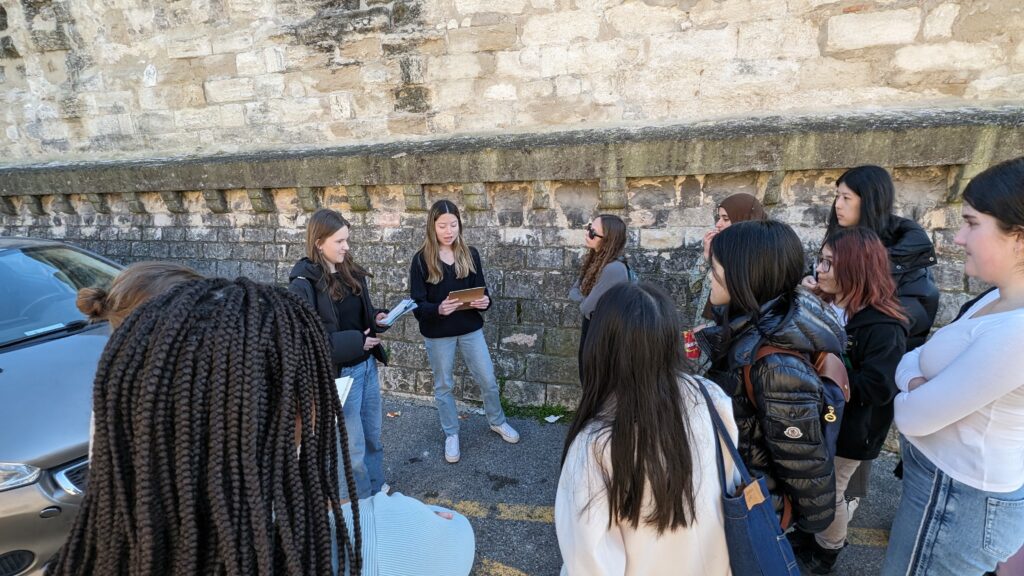
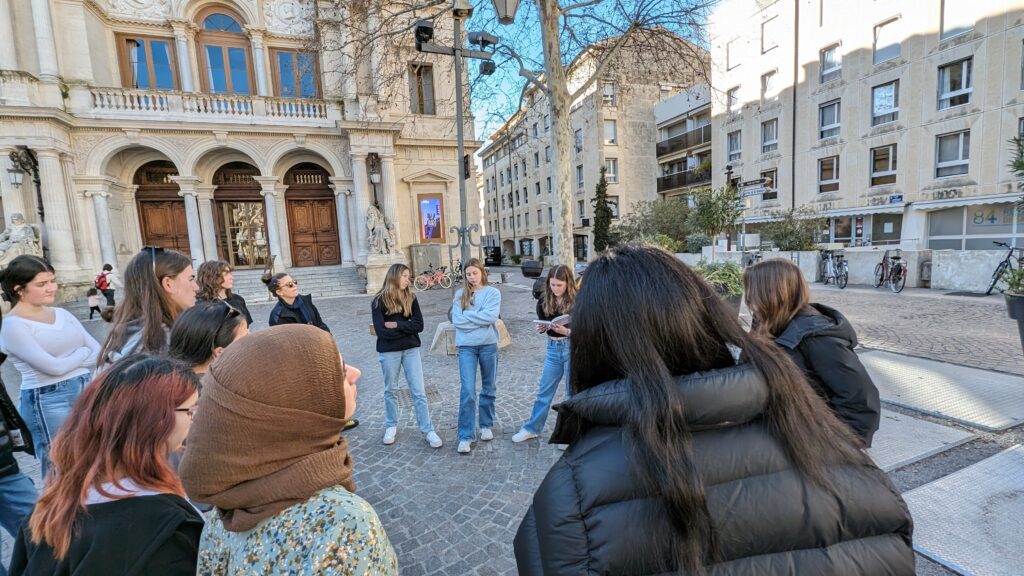
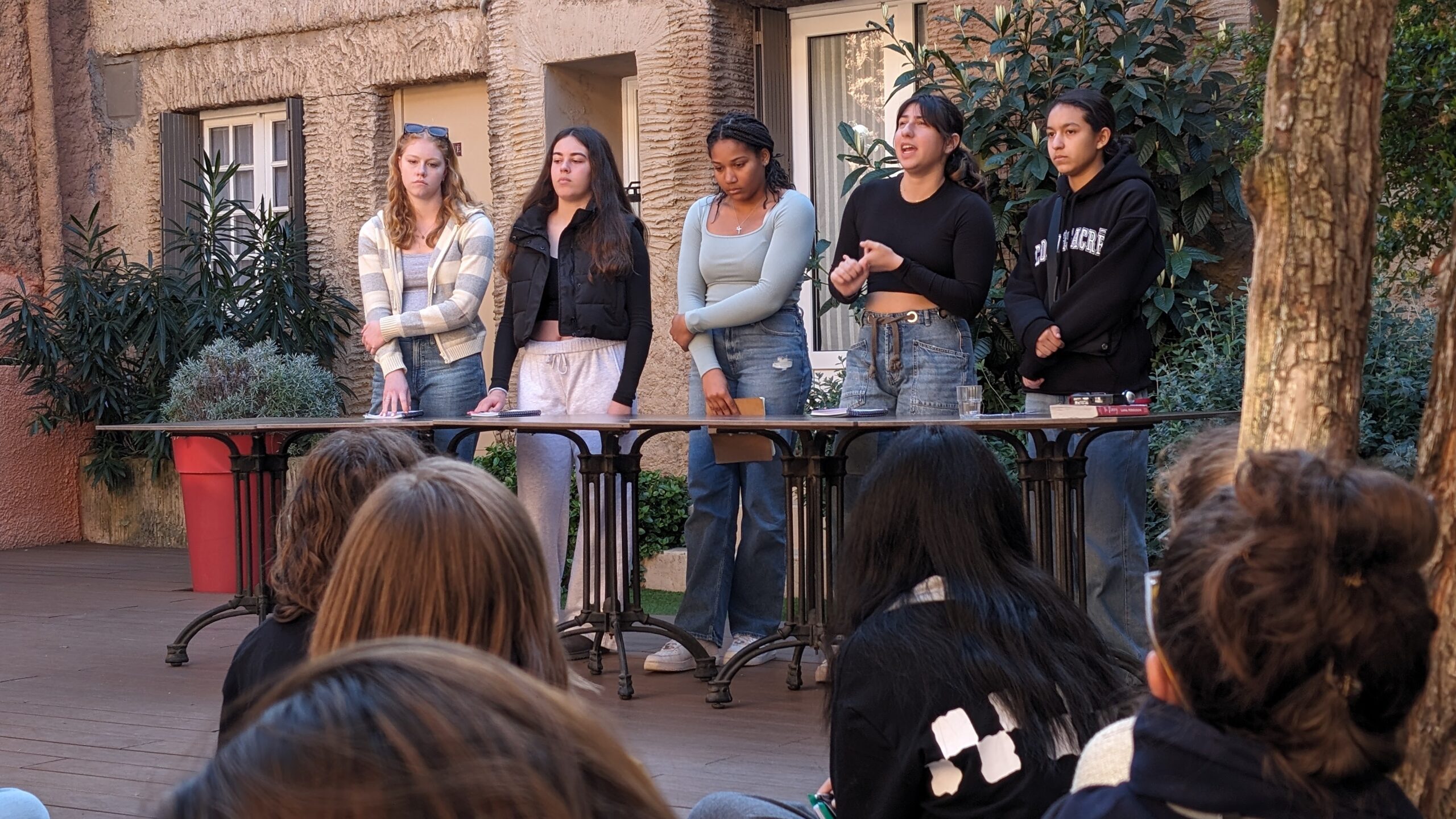
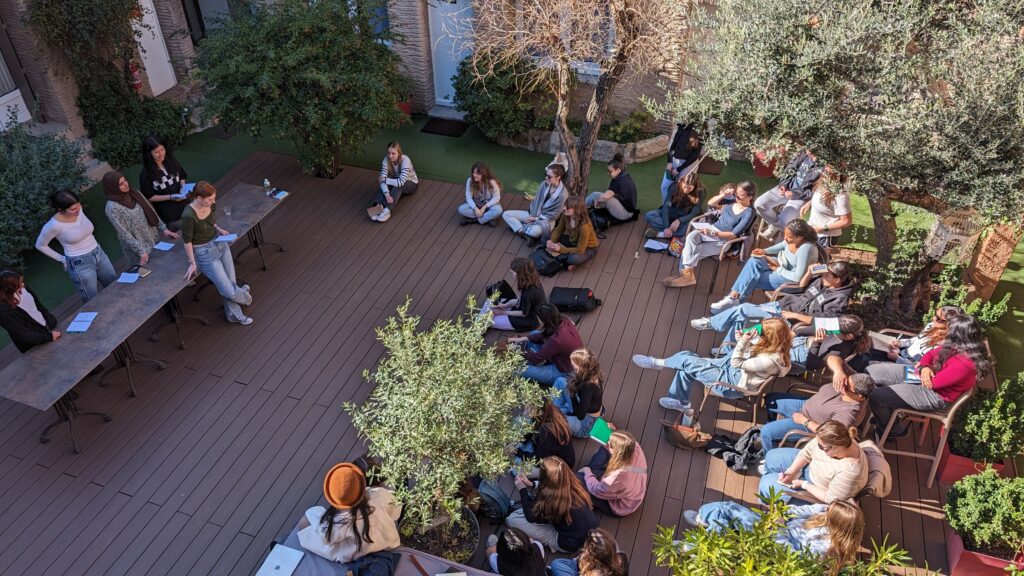
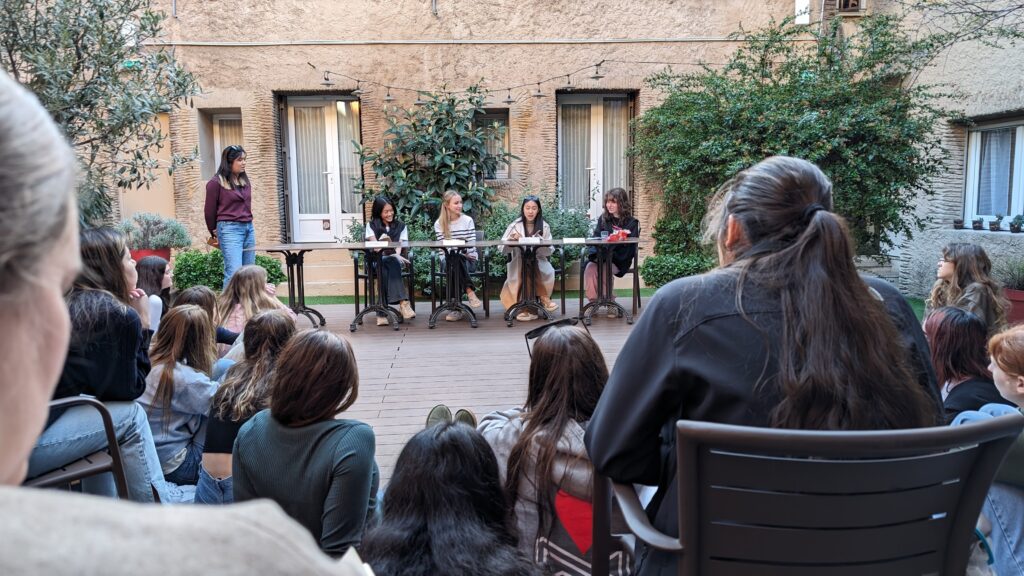
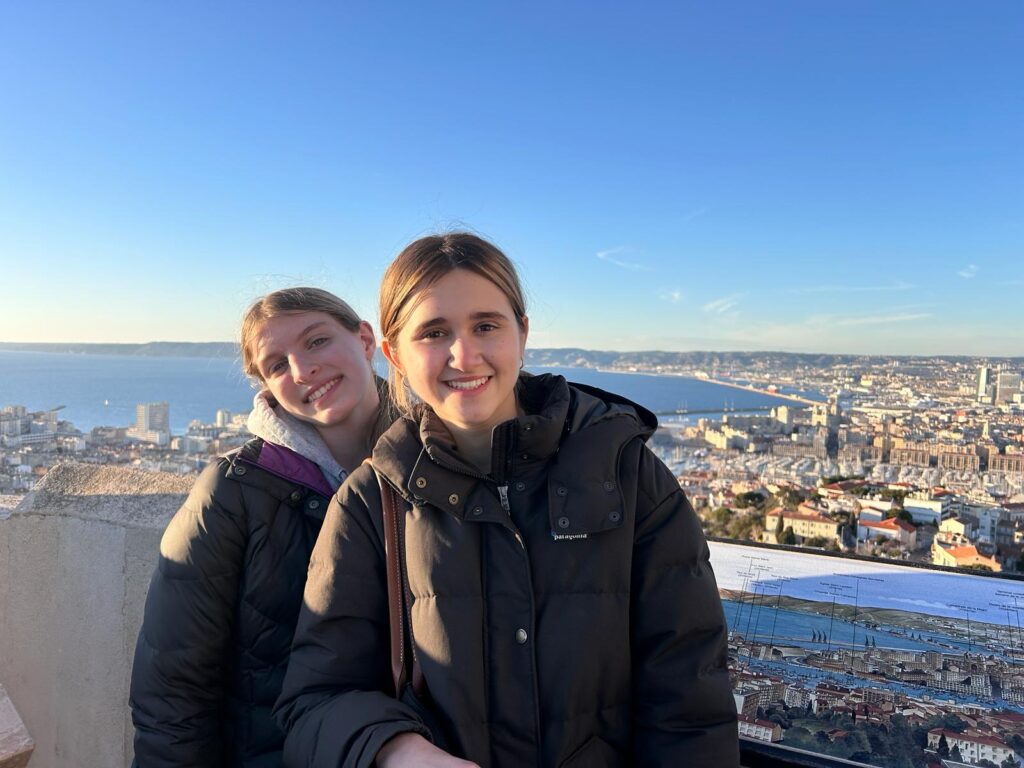
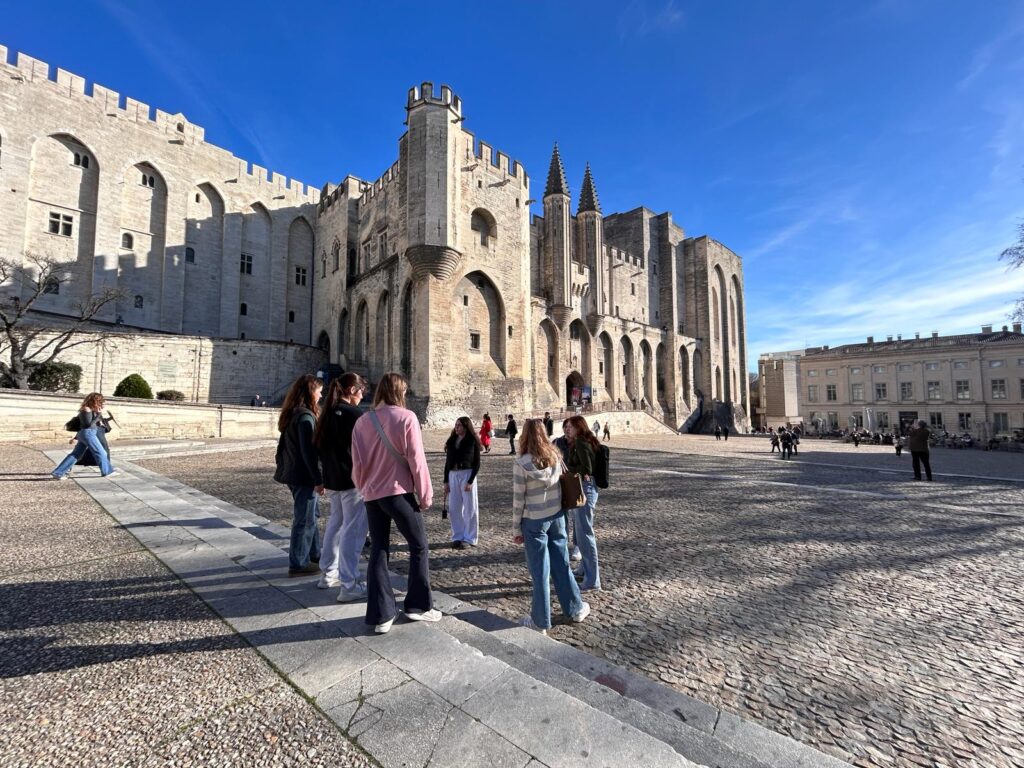
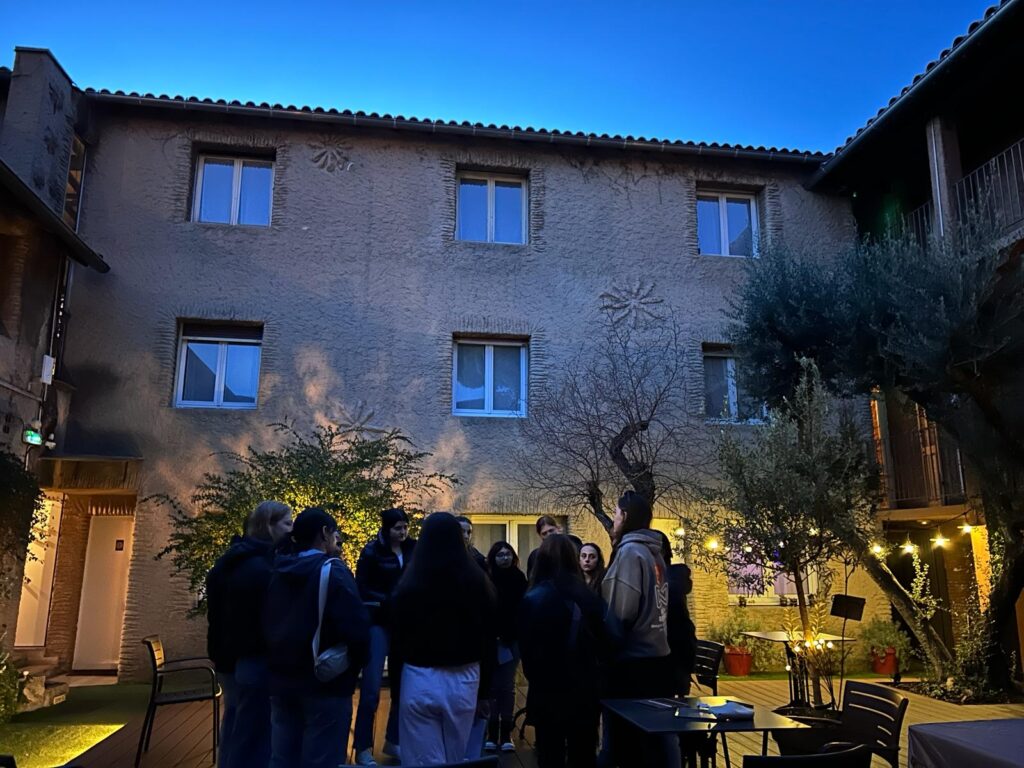
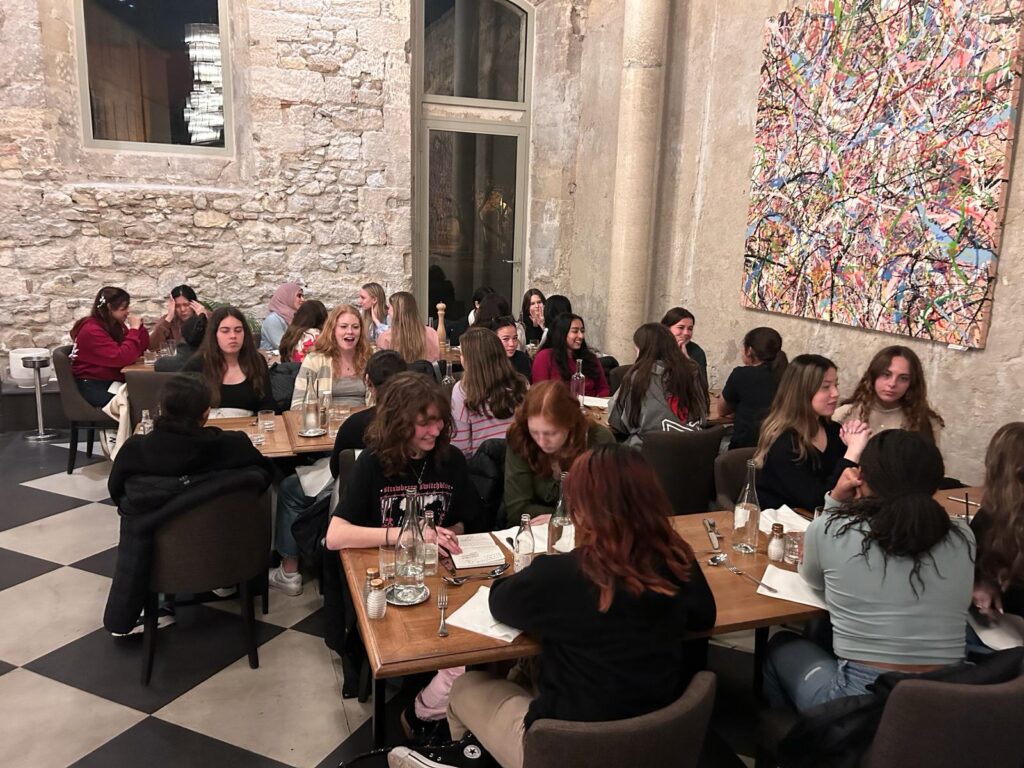
February 13
Student Authors: Sarah J. and Isabelle O.
Today was a long, yet rewarding, day. We had an early start by getting on the bus and heading to Marseille. We then met Olivier and someone from the Clean My Calanques team. With them, we picked up trash in a beach cove for 40 minutes. After that, we headed to lunch at a pizzeria where neither of us got pizza, but the food was yummy. We then got a little free time around the Marseille docks.
Our next stop was La Cité Radieuse, an apartment complex designed by famous modern architect Le Corbusier in 1945, which had duplex apartments that were open and filled with natural light. This was a modern and unique design at the time. There were also parakeets outside for some reason. The rooftop view was a little weird because you couldn’t see much except the sky, to resemble a ship’s view. There was a floor in the middle that was dedicated to just shops and businesses, like a street. Our final stop was at the Notre Dame de la Garde, after some fun singing on the bus, which included some serious Bohemian Rhapsody karaoke. The basilica had beautiful views, and a pretty peacock embellishing inside. We also accidentally ended up in the crypt somehow. Finally, we had independent dinner, where we got Vietnamese food, and the lady even gave us free mochi! Merci beaucoup! Also we are sad we didn’t get to pet the ginger cat today, as well as all of the dogs we’ve seen on the trip so far. Even though it was a long day, we still had fun, and can’t wait for our last full day in France…
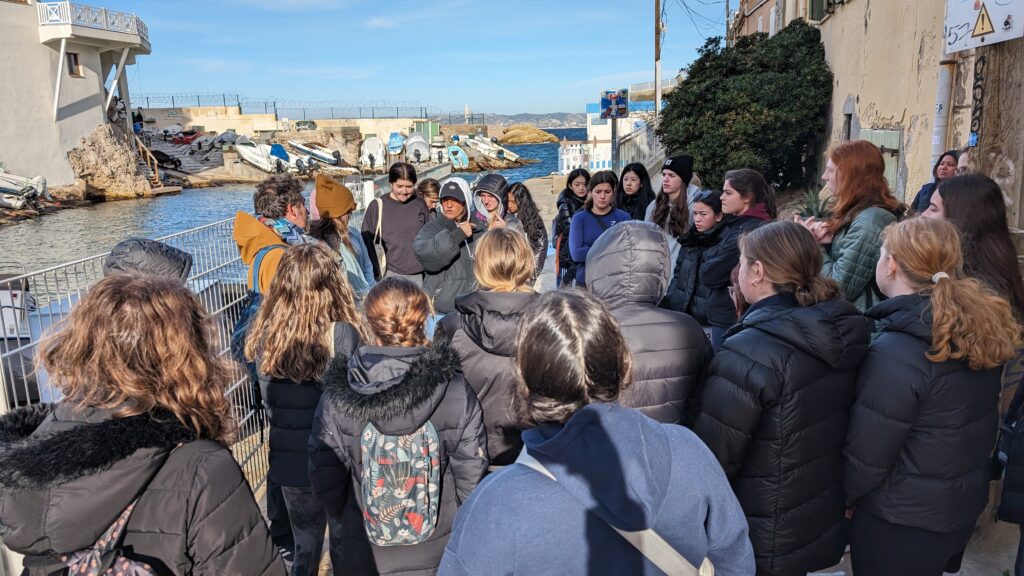
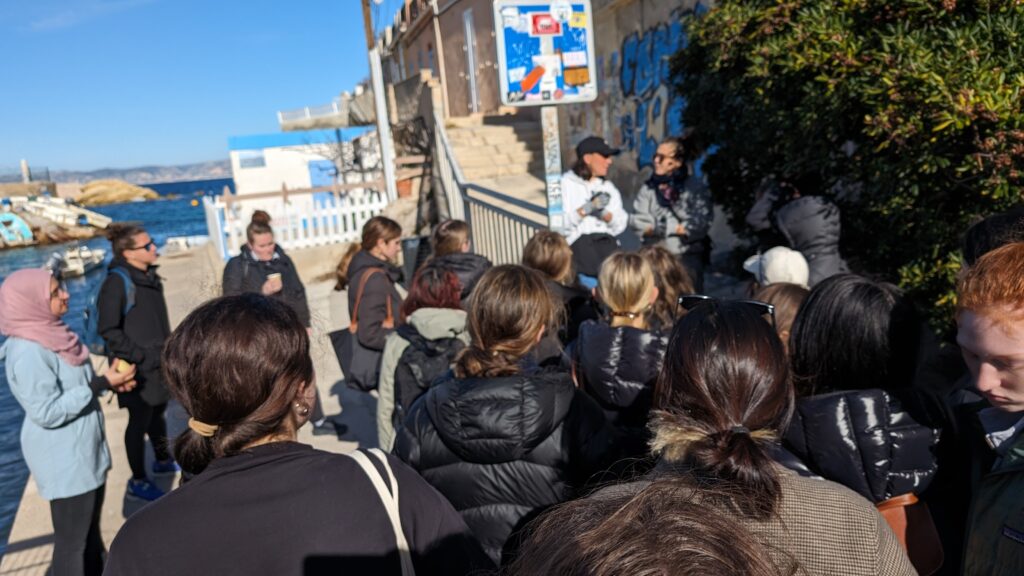
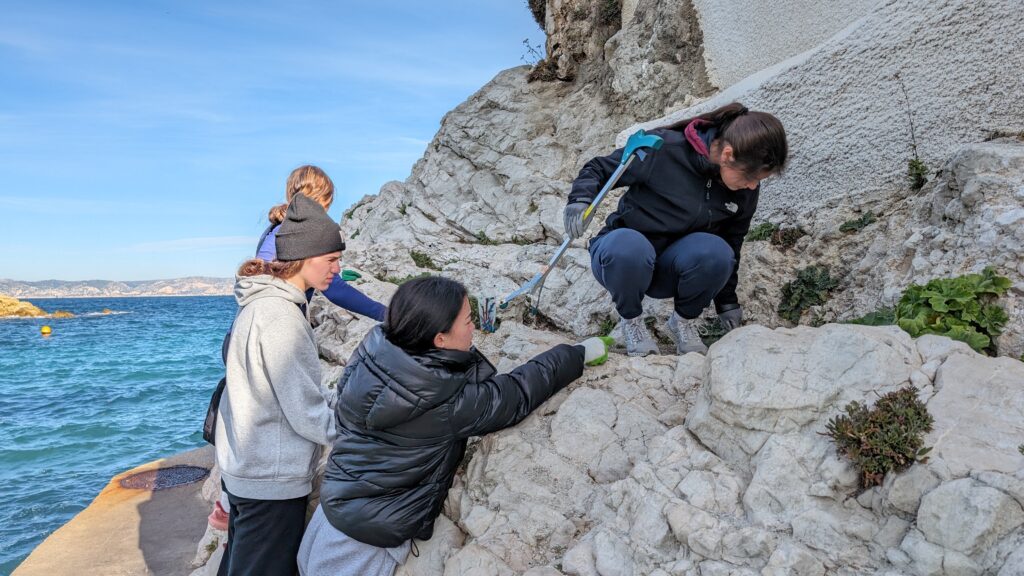
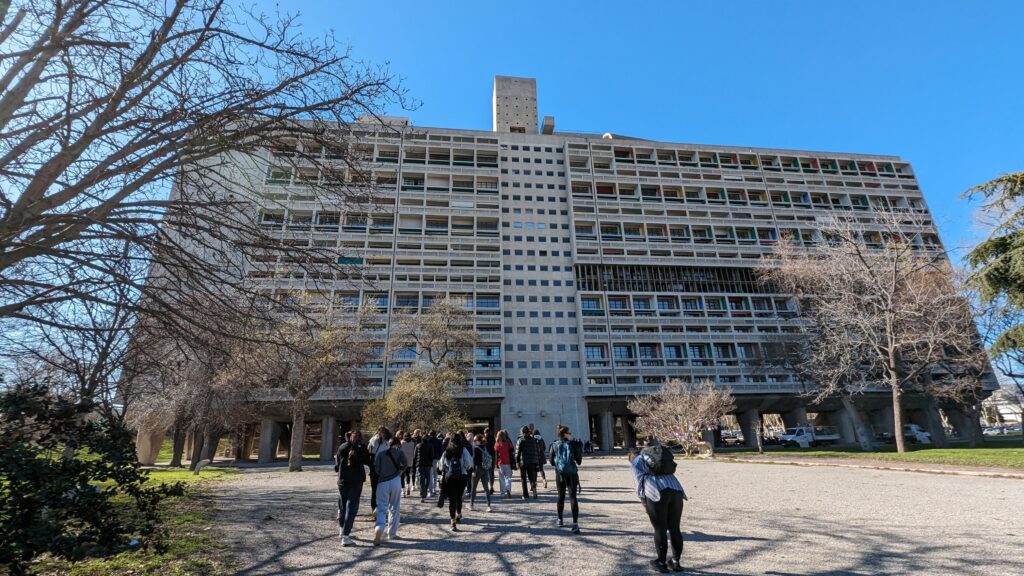
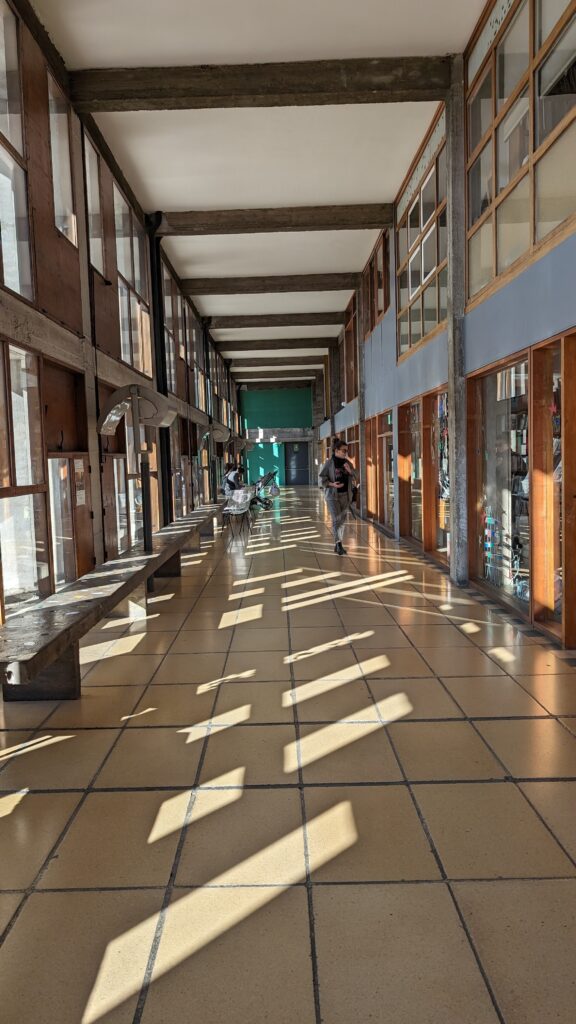
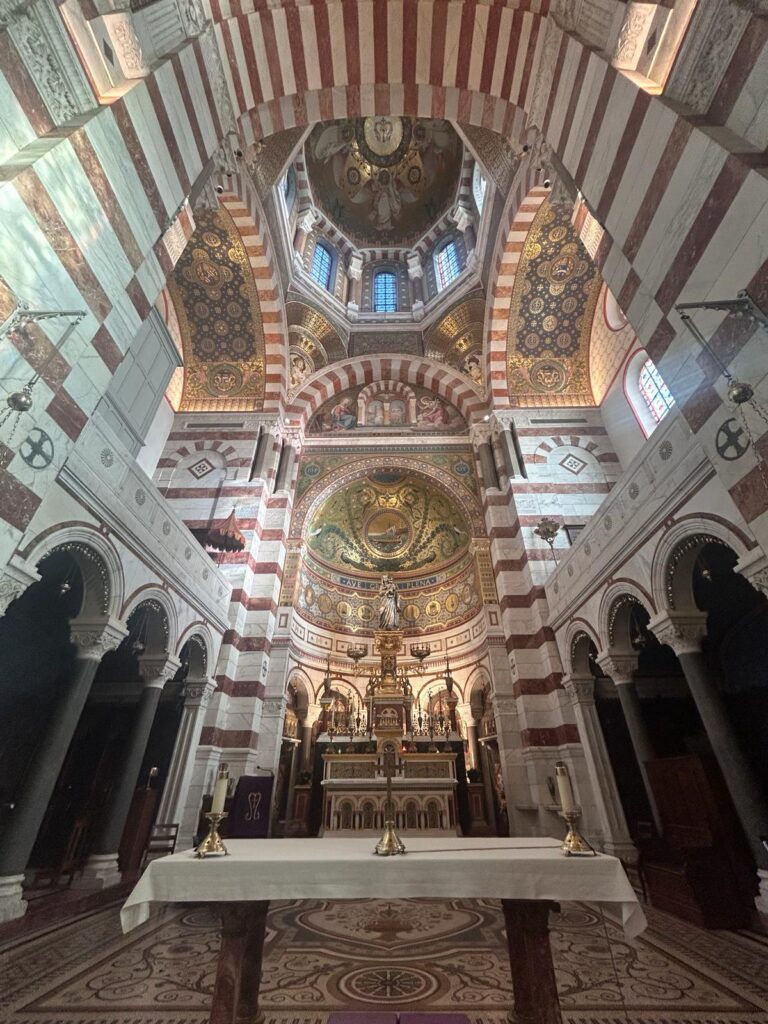
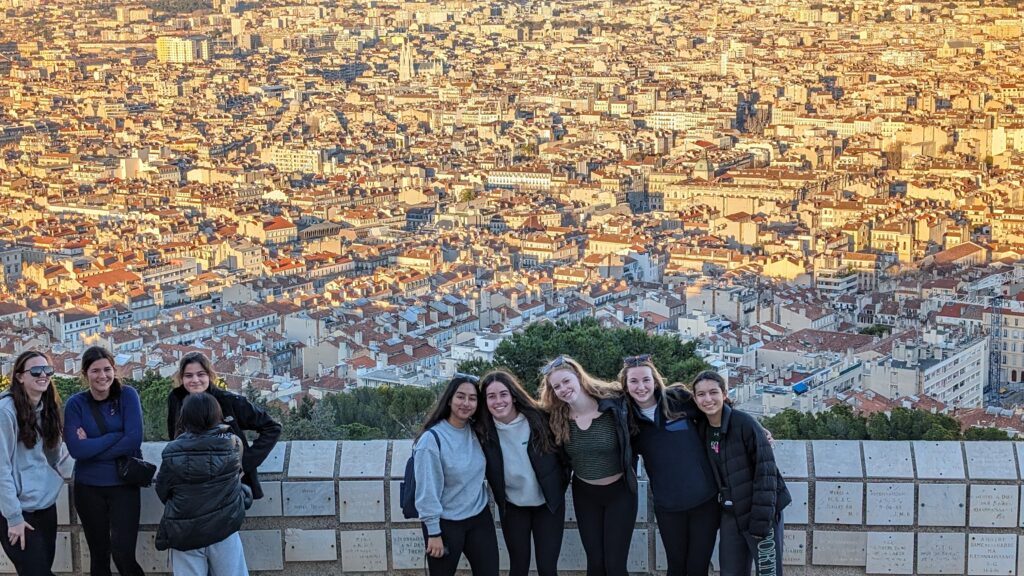
February 12
Student Author: AJ C. and Fiona G.
Hi all! Monday was filled with learning and traveling! When we arrived in Marseille, we met up with Eric from Clean my Calanques and Olivier. Eric did a presentation and talked to us about how he started Clean my Calanques by hiking and picking up trash with five other friends. Clean my Calanques aims to educate the locals of Marseille on sustainable solutions for their trash, rather than shaming them on littering the beaches. Did you know that they can pick up 5,000 cigarette butts in one hour?! However, there are 100,000 cigarette butts disposed of every day in Marseille. After Eric’s presentation, we had some free time to explore the official merch of the Olympique de Marseille soccer team and an outdoor mall. Then we got on the bus to Aix-en-Provence.
After the 45 minute bus ride, we walked to the Hôtel de Caumont Art Center, where we walked around learning about the history of the mansion and the restoration that was done in the palace. Fun fact, one of our tour guides, Elsa, grew up in Aix and attended classes at a school of music in this building before it became a museum. After finishing the tour of the mansion we went on a guided walk around Aix-en-Provence by the one and only Elsa. She showed us around her home town and told us stories of her childhood. We loved listening to the different stories of the town from Elsa herself. We then proceeded to walk to the bus and headed back to Avignon for dinner and rest.
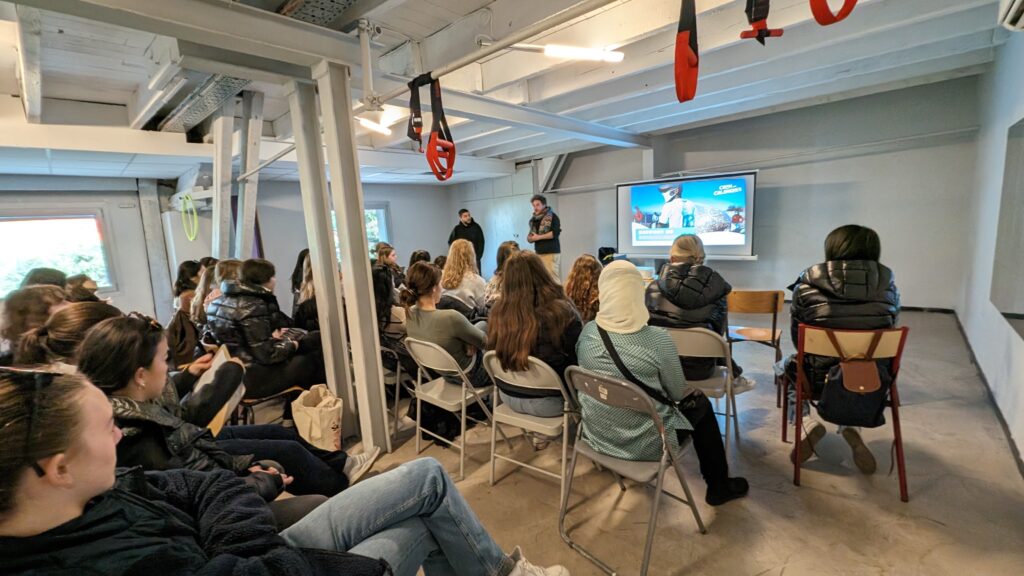
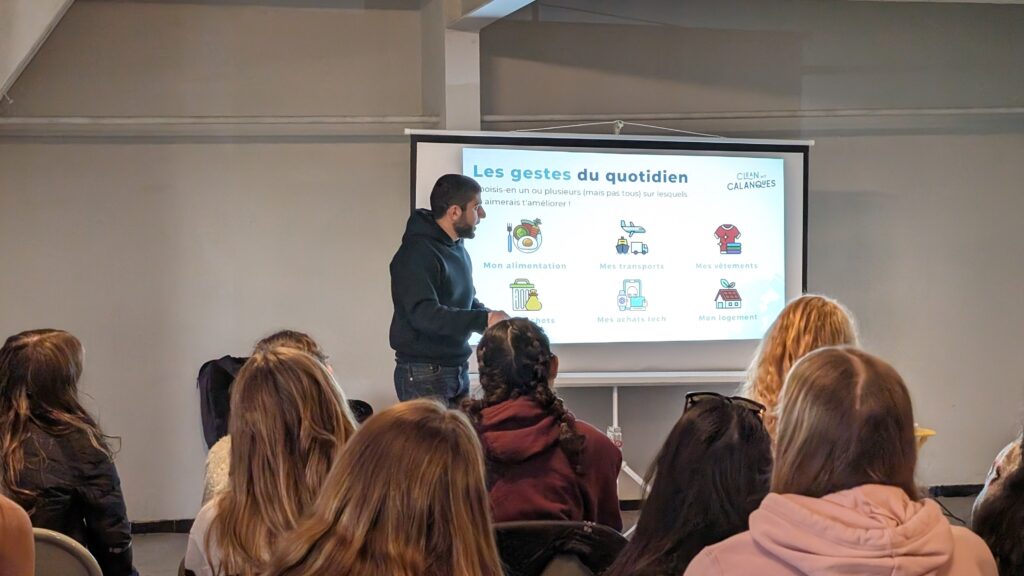
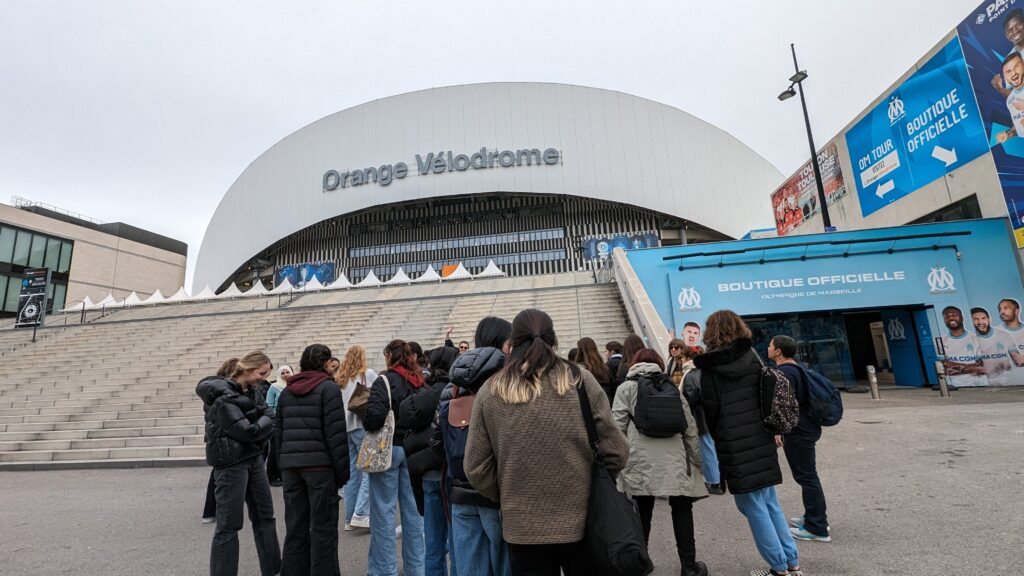
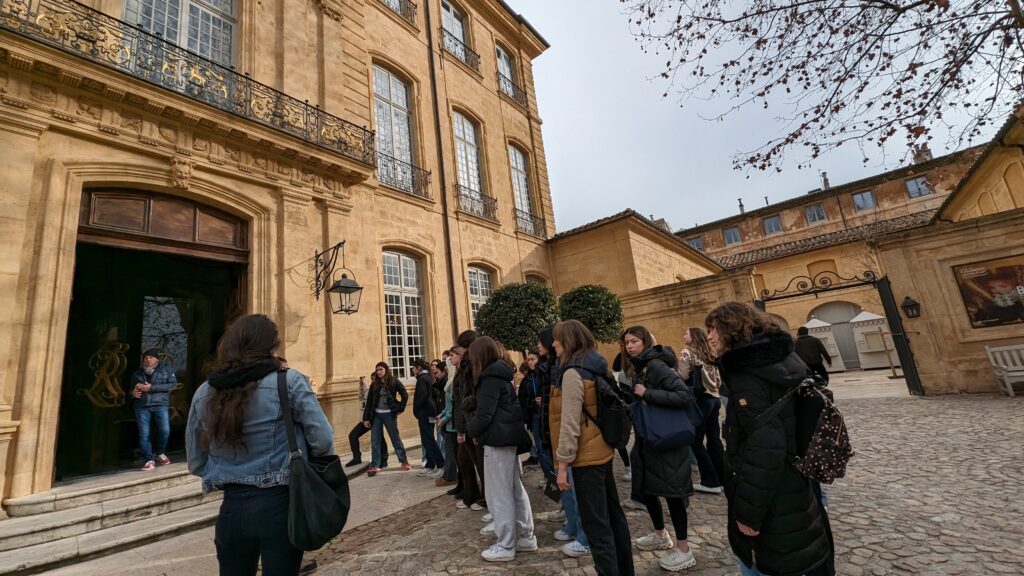
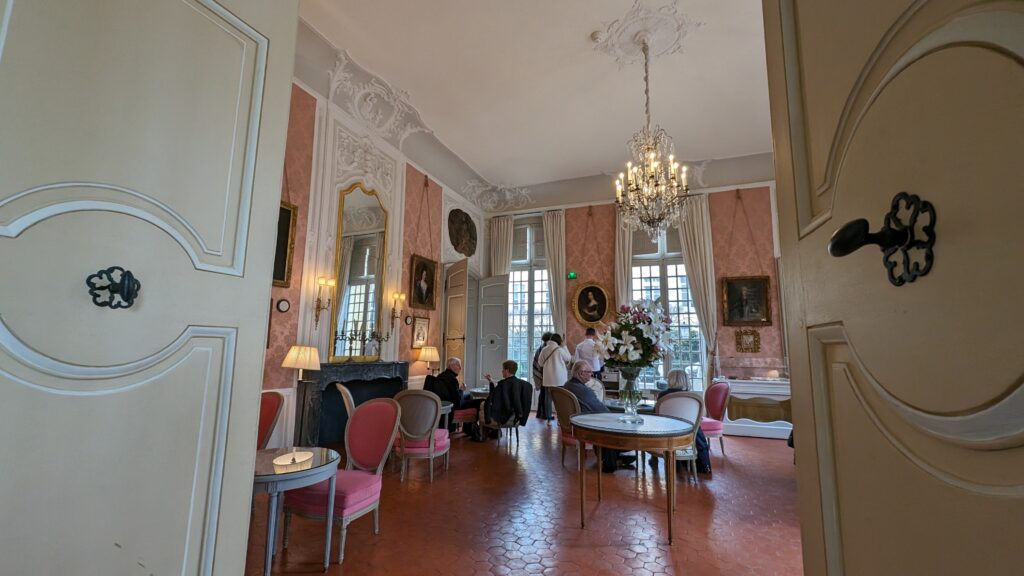
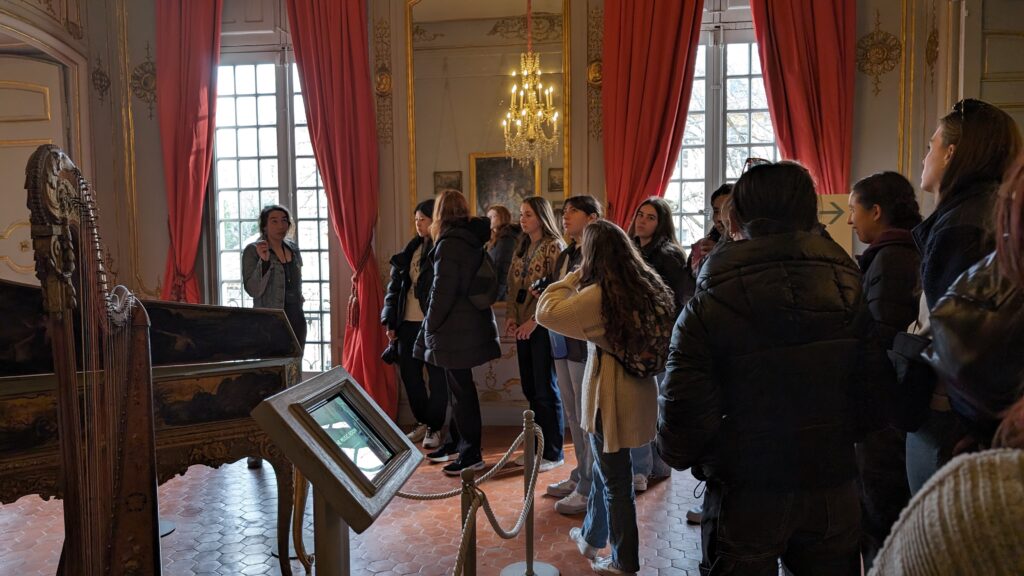
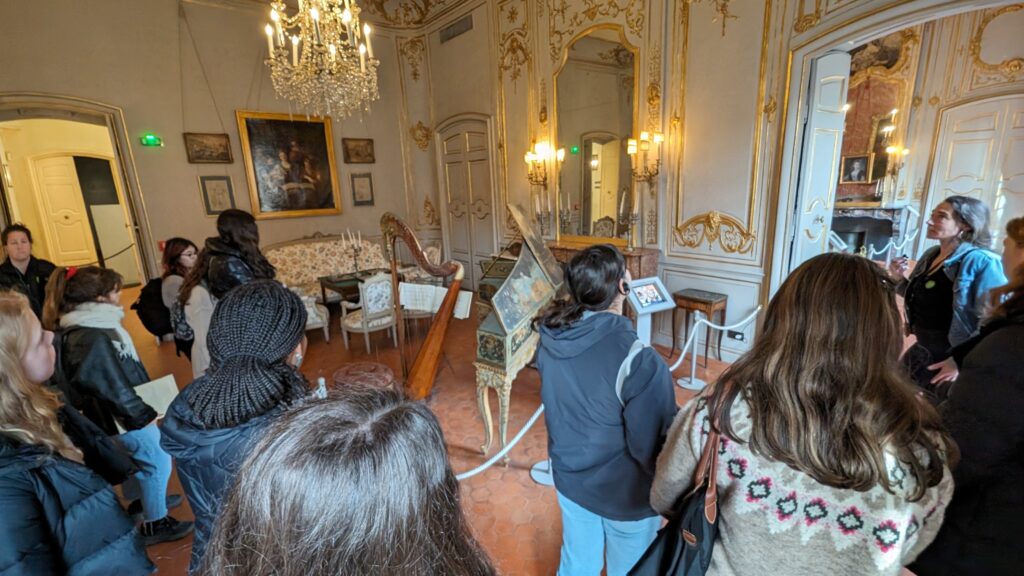
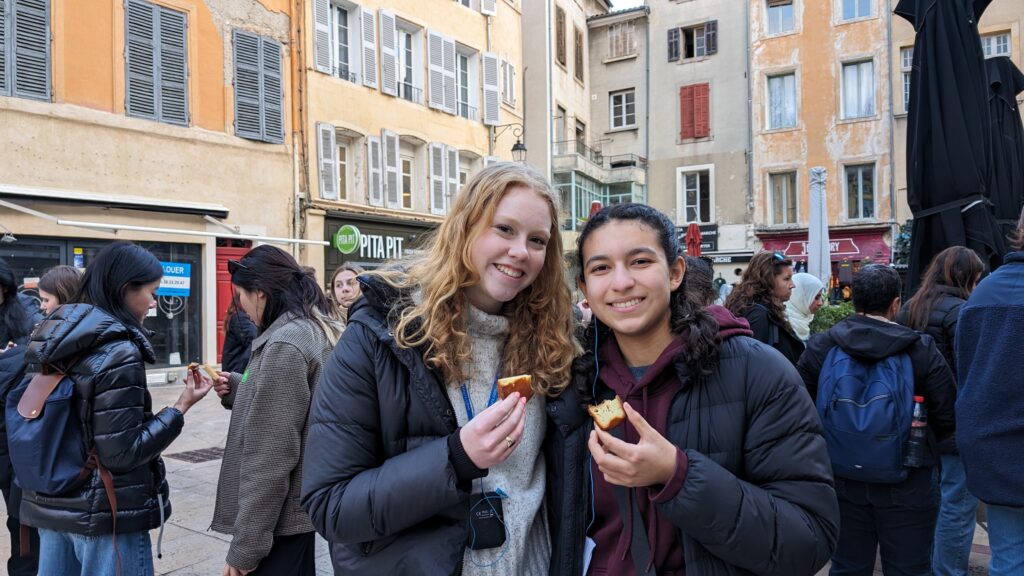
February 11
Student Authors: Maryam A. and Seneca F.
Today was a chill day to do laundry, relax and work on our projects. We slept in until 9:00 a.m. and had a late breakfast. Then we met in groups about our final projects for this trip (non graded!). Maryam and I are in different groups. Maryam’s group for their project will be interviewing people in Avignon to understand what life is like for the residents of the city. Seneca’s group is designing an interactive tour about how tourism within the community impacts the city’s culture.
Then, around 1:00 p.m., we ate some delicious Vietnamese food outside in the park! After some group bonding games, we spent what felt like three hours at the laundromat. Then we went to a restaurant for dinner, and we had the most sensational, fantastical, delicioso dinner ever to exist.
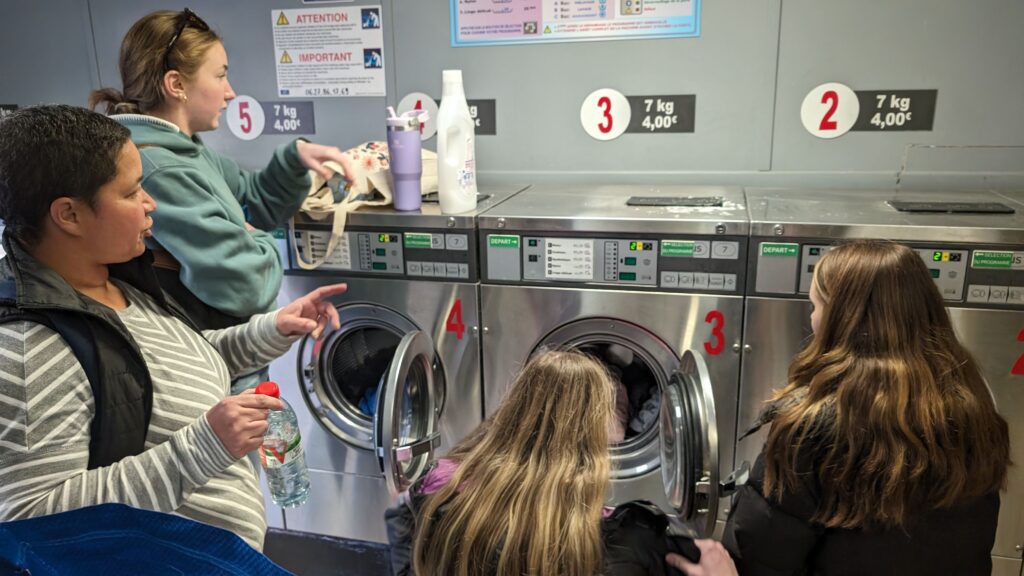
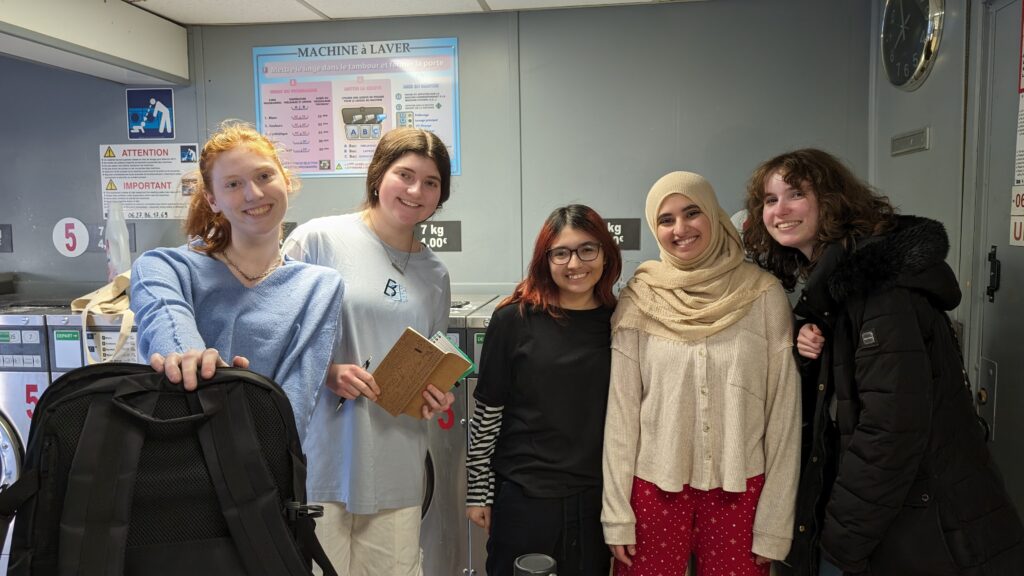
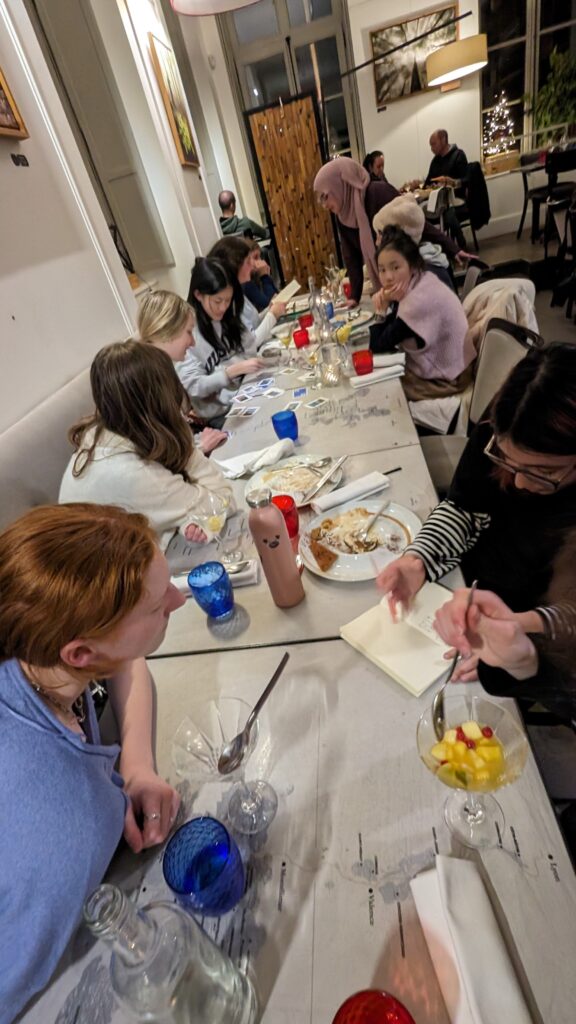
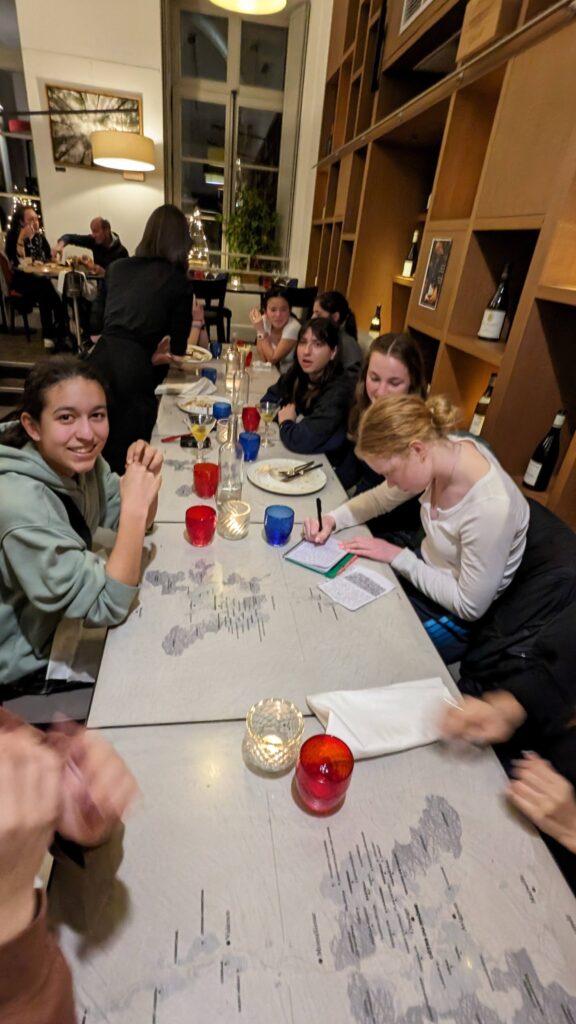
February 10
Student Authors: Kate H. and Dahlia M.
Hey guys! Today was another amazing day in France. We braved the rain as we made our way to Arles, a town close by to Avignon in the delta of the Rhône river. We visited Roman ruins and enjoyed experiencing one of the oldest open-air markets in France. The market was full of colorful produce, charcuterie, all kinds of cheeses and many other regional products. Walking through this area definitely enhanced our experience in France as the locals were excited to present their products. Lunch was DIY so we were able to try a bunch of the different cuisines Arles has to offer. Some favorites included ramen and crepes. After lunch, we went on a tour of LUMA, a cultural center /museum designed by Frank Gehry. Our favorite things included the exhibit exploring Artificial Intelligence and its effects on the art world; an exhibit of Diane Arbus’ photography that included the picture that inspired “The Shining”; and the large twisty slides where we were able to race our peers. Another feature of the building that we appreciated were the salt walls, which naturally removed moisture from the air, replacing the need for air conditioning. Au Revoir!
Student Author: Milla P.
Today, we took the train to Arles. The weather was rainy, but it didn’t stop us from exploring the sites. We had a lovely tour of some Roman monuments and other interesting establishments of the city led by Elsa. After the tour, we had some free time to eat lunch and shop around the local outdoor market. A few of us had margarita pizza and an éclair, and some tuna avocado tartare and tiramisu. Some damage was done (€) at a French streetwear brand called “Bisou” or “Kiss” in English. The rain cleared and we made our way to Luma. We saw a lot of modern art that was quite the contrast with the Roman style museums and monuments that we saw earlier. One of the highlights of Luma was the double slides that were also considered as an art piece. There was also a wall made of salt and another wall made of plant material which felt soft to the touch. The photo exhibition of Diane Arbus was also very interesting to look at and we enjoyed learning about her as a photographer. Finally, we walked back to the train station and went back to the hotel for some free time.
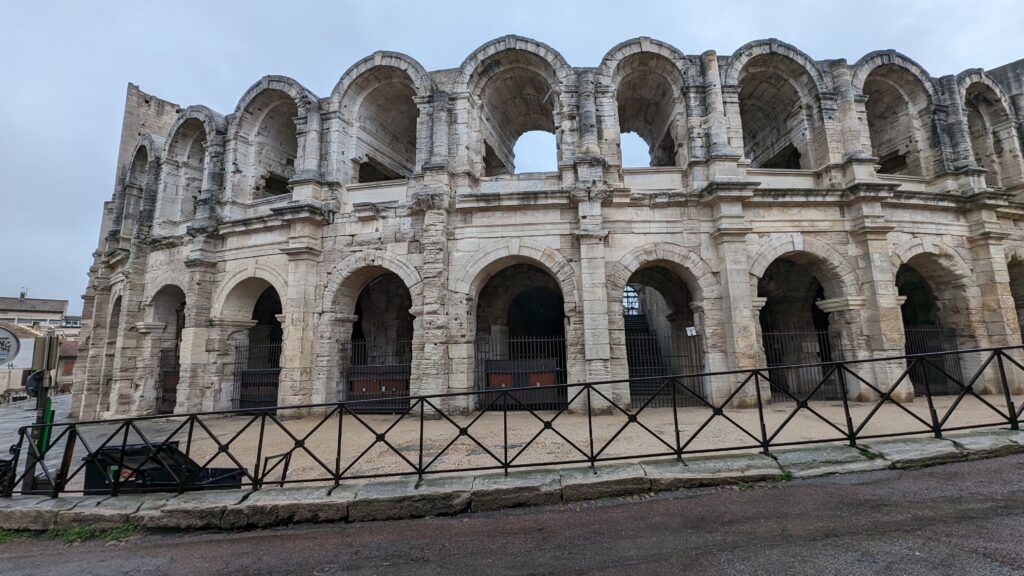
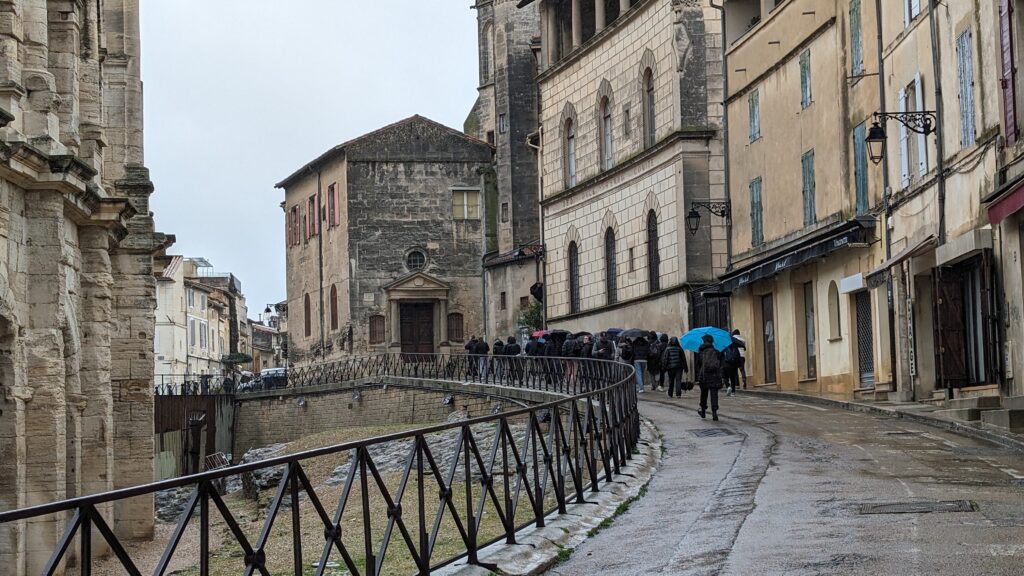
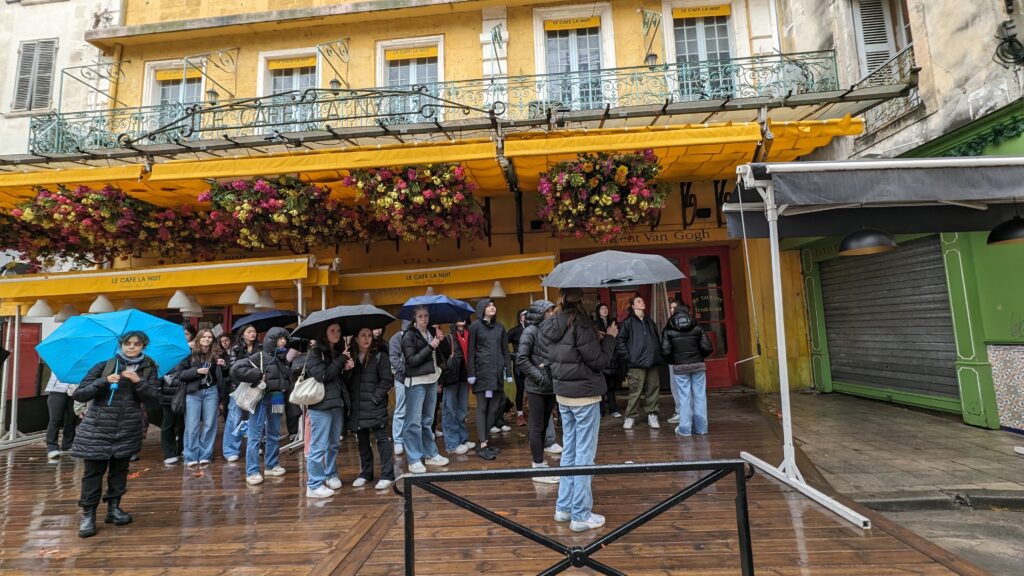
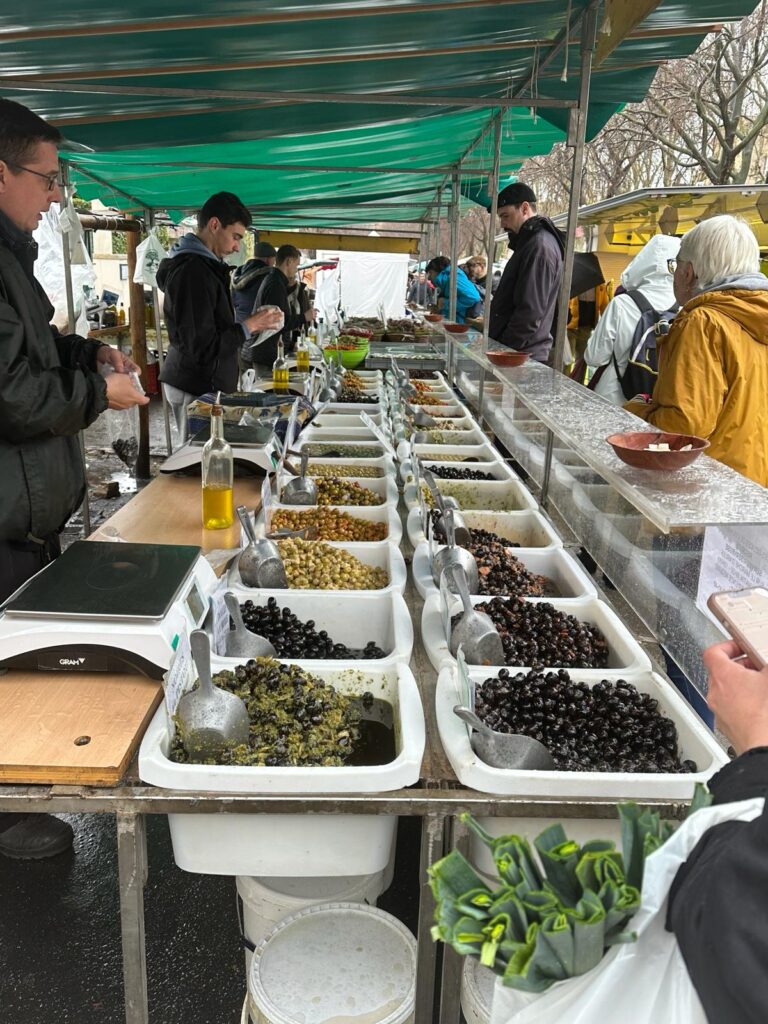
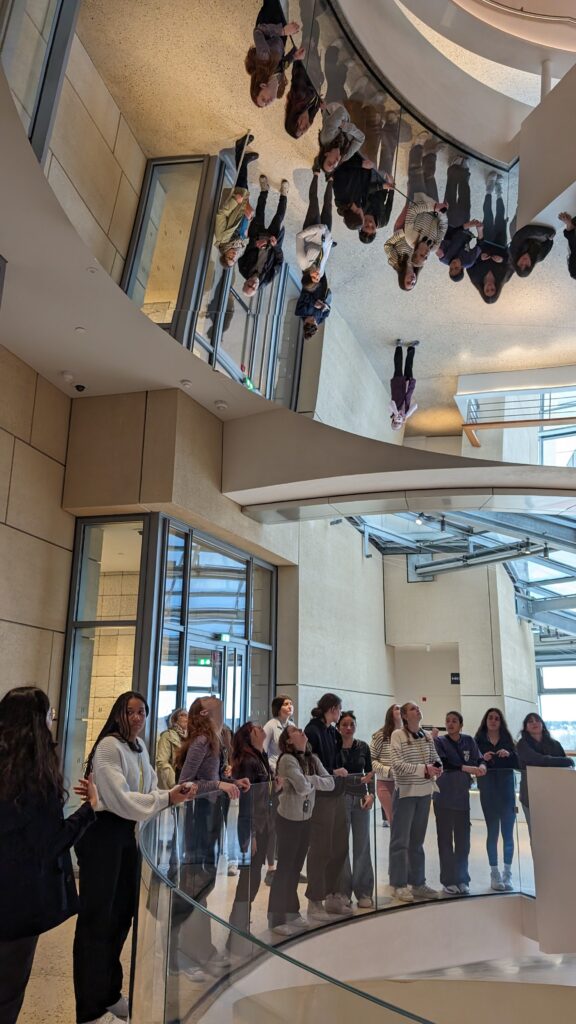
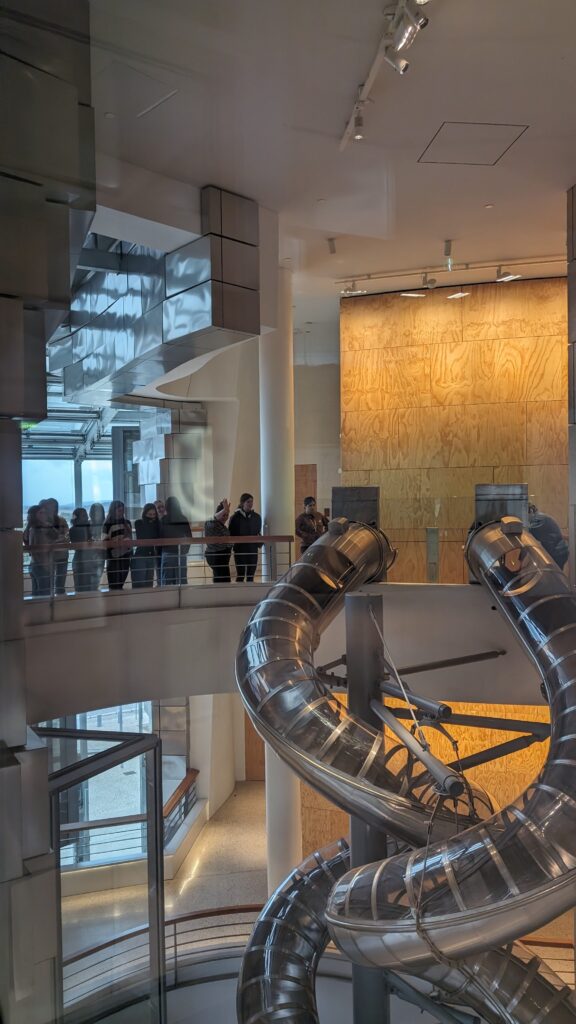
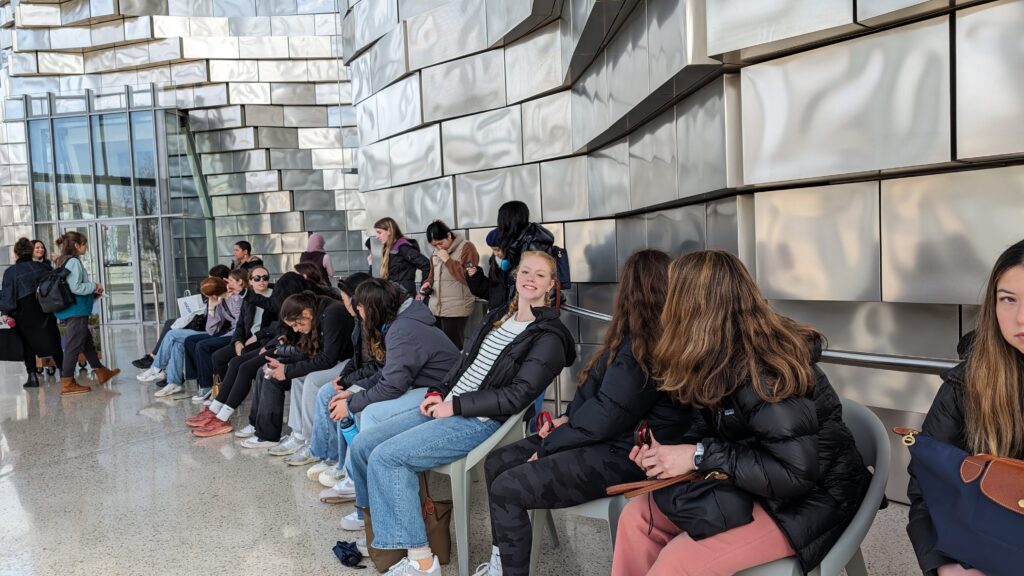
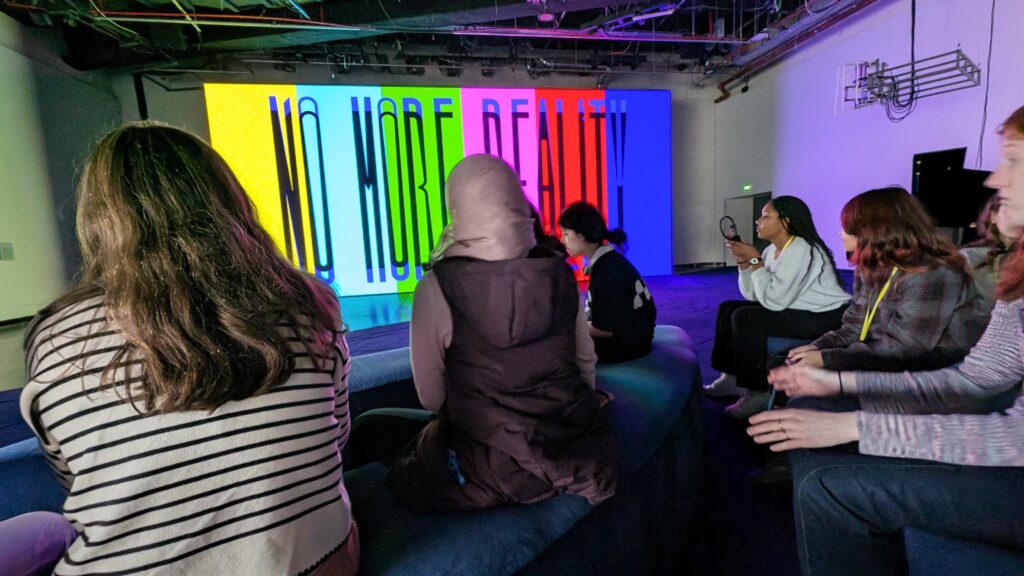
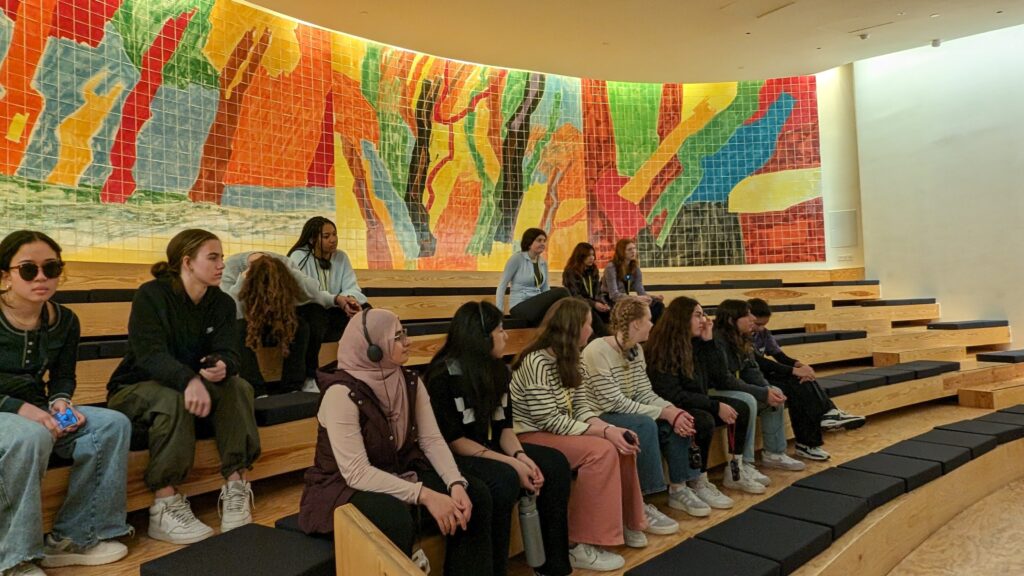
February 9
Student Authors: Bella D., Ashleigh F, Kalynn H., and Hanna S.
Bonsoir everyone,
Despite the gloomy, cold, and rainy weather today, we had a blast. We started off the day with munching on some chocolate croissants. Soon enough, we headed for the bus. Elizabeth brought the speaker. Bella and Hanna were stoked for the bangers on the playlist. Sadly, there were only a few.
Once we arrived at the hiking site, Charlie and Chris, a.k.a. pro-hikers, guided us through the woody mountains. We walked in the beautiful Mediterranean forest of the region, and after rolling our ankles 17 times we made it to the first remains of the aqueduct! This is an aqueduct that has been rebuilt three times since the first century A.C. When the aqueduct was in use, it provided clean drinking and bathing water for the locals. Some of the current aqueduct sections standing today were restored 150 years ago. Today, it is no longer in use, and it stands as a monument to showcase the Romans’ advanced architecture.
We then continued through the rocky and sometimes slippery trails. When we made it to the top of the mountain, rain started to fall as we got our first glimpse of the Pont du Gard. The Pont du Gard was a beautiful sight. It is a large Roman aqueduct and bridge crossing over the Gardon river. It had multiple arches spanning over 900 feet, and large stones that Romans once used to hike up the bridge.
Then we headed back to the hotel, where we had baguette sandwiches for lunch with cream puffs for dessert.
Shortly after, we headed over to the Université d’Avignon. Once we got inside, we split into tour groups led by current Université students. We learned that this is one of the oldest universities in France, founded in 1303. We also learned on the tour that the building used to be a hospital a long time ago. The students explained how the wide stairs in the building were once used for horses to carry the sick people to their hospital beds.
After the tour, we had a lecture by Professor Simon Renoir, where he talked about his research with cities, specifically urban regeneration in Detroit.
After our visit to the University, we retreated back to the hotel for some chill time, before we met up with our groups to discuss our projects. Then we headed out for a tasty, delectable supper. It was busstastic. Total gas. Once we were put into a food coma, we dazed off to our hotel, ready to slumber.
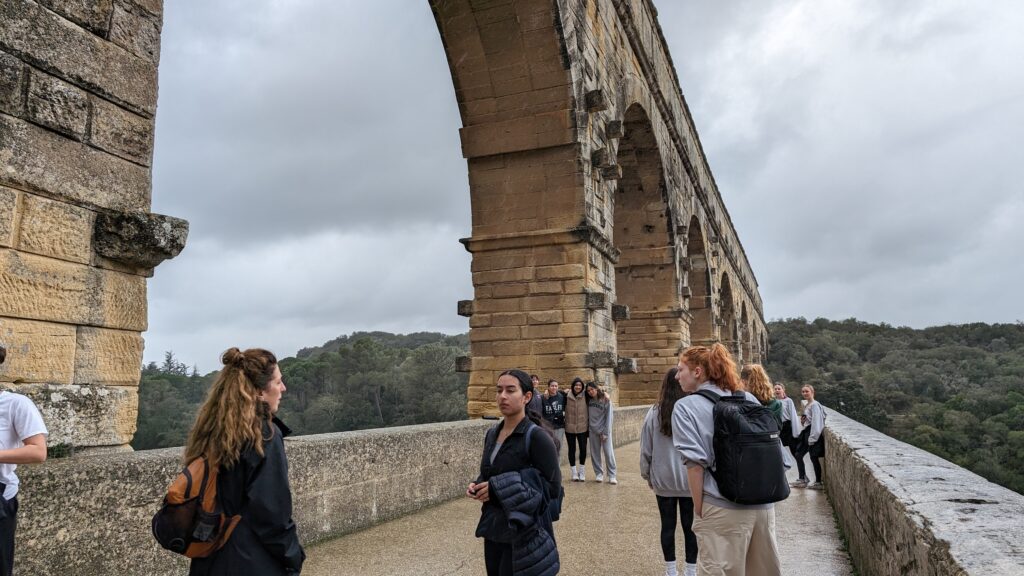
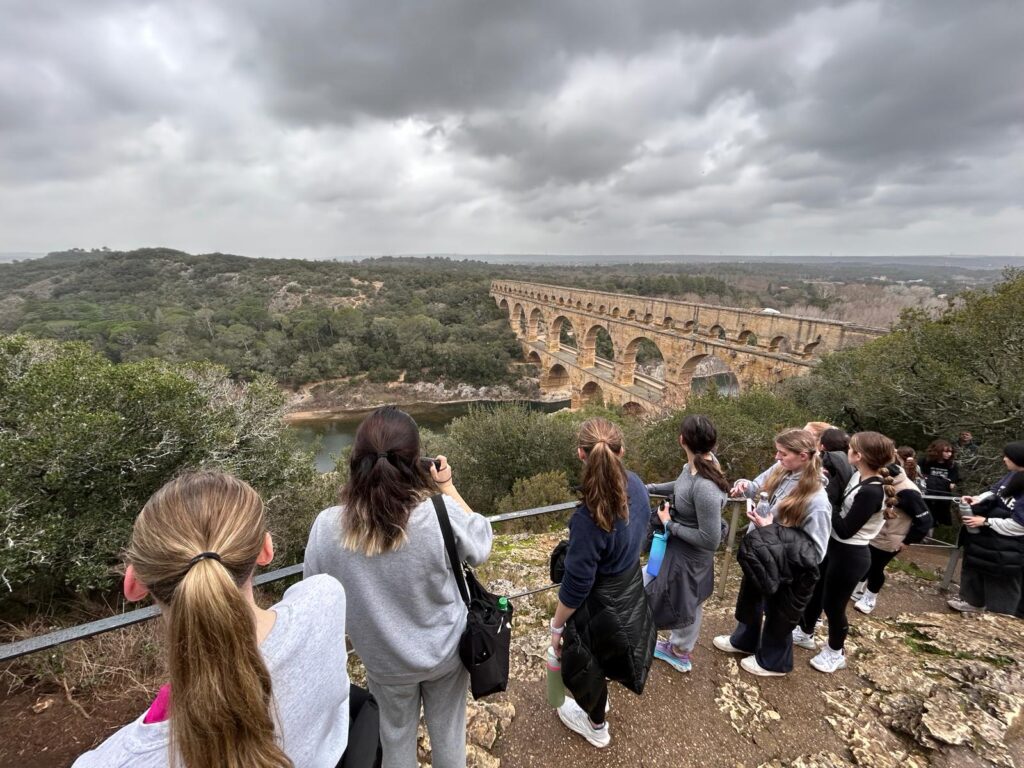
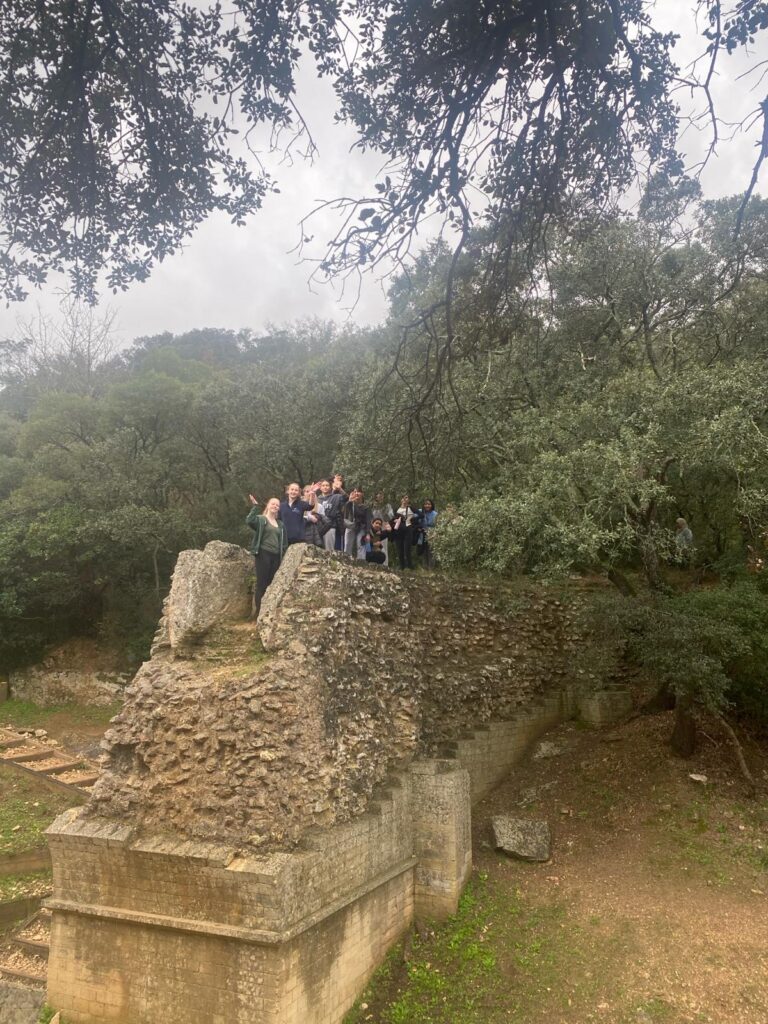
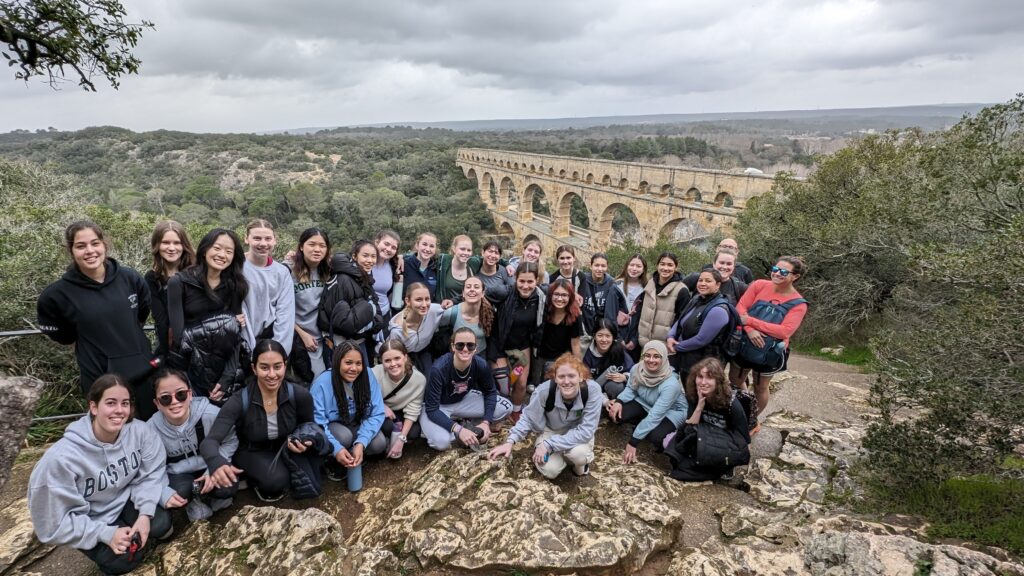
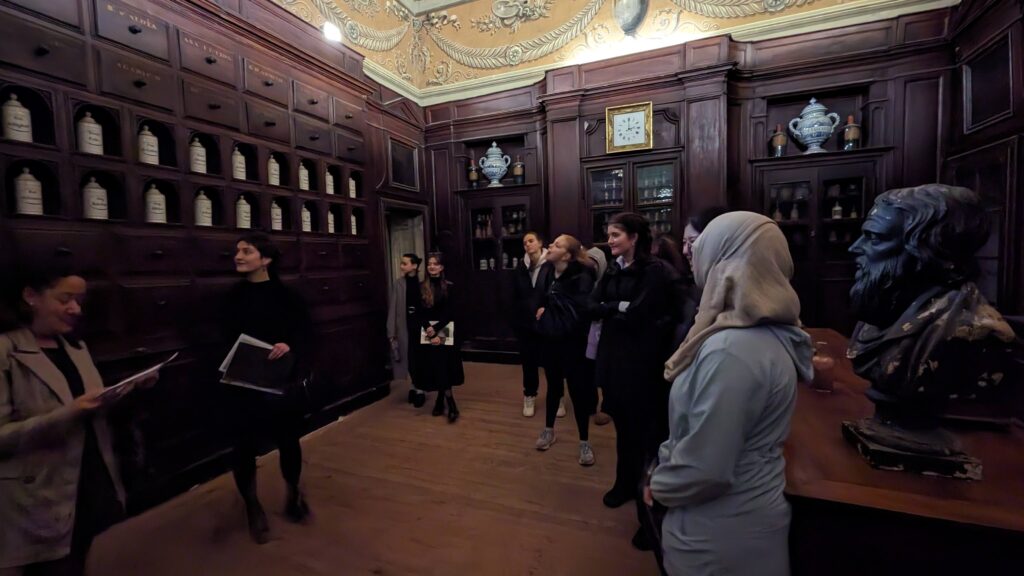
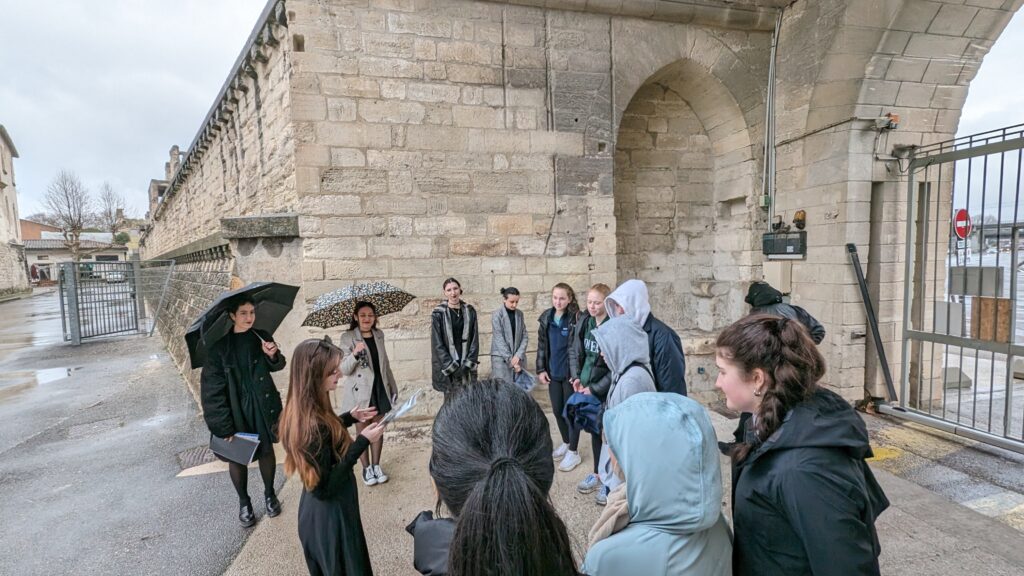
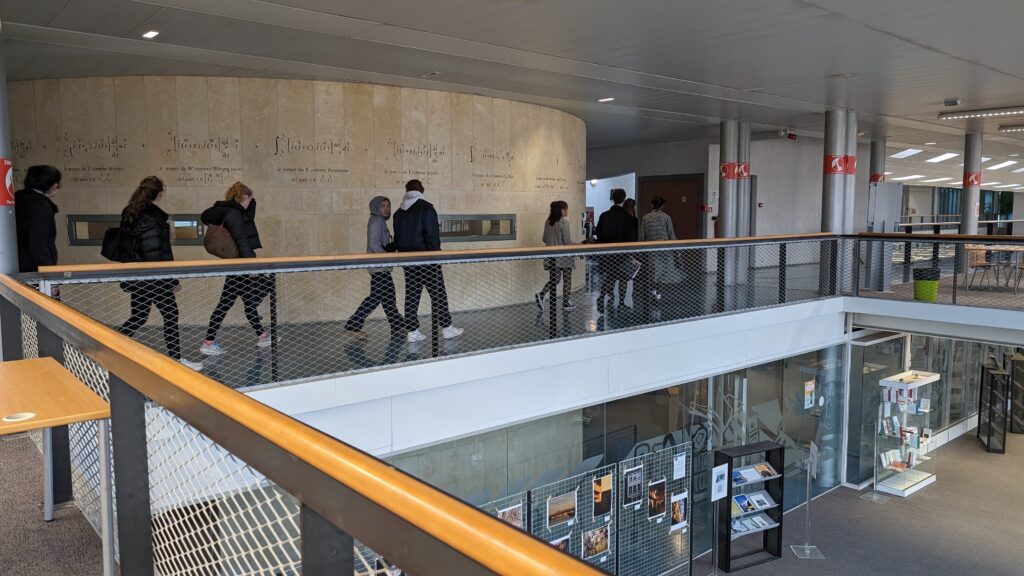
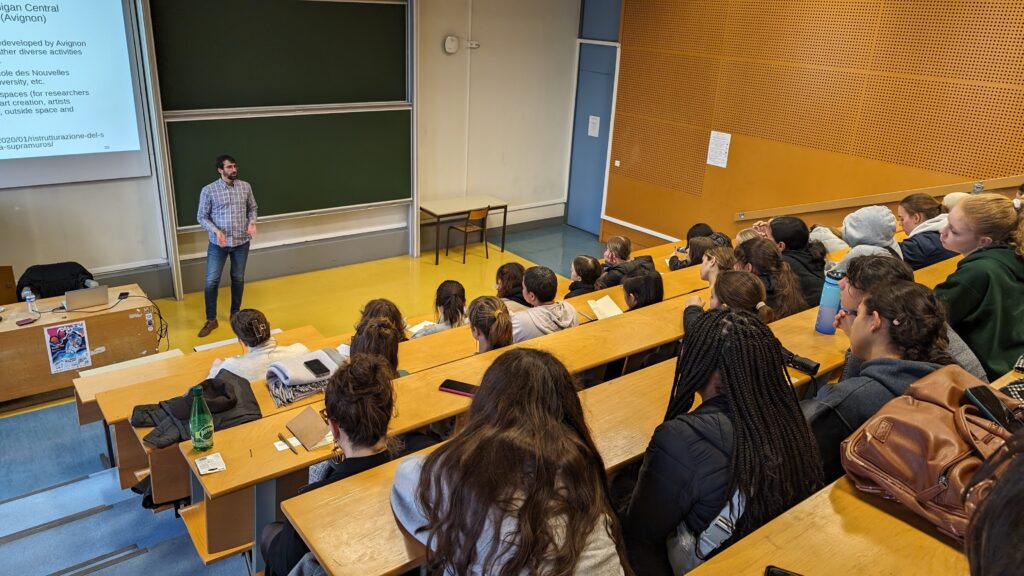
February 8
Student Authors: Bee A. and Katherine T.
Bee: Today we made our way to a bustling central market in the city. The market was lined with different food stations, each featuring a different food local to Provence. There, we met up with Chef Johnathan, a renowned cook here in Avignon, for a cooking demonstration. We began with trying three types of locally made goat cheese, each having vastly different fermentation times and techniques. This was to demonstrate the subtleties and attention to details used for each cheese.
After our tasting we began the cooking. We began preparing the dessert: A lavender honey cake. As the students began cracking eggs and mixing batter, Chef Jonathan explained the importance of locally sourced ingredients. An example was the lavender honey, which is sourced from bee hives strategically placed near the lavender farms that stretch across Provence. As we moved on to preparing our first and second courses (squash soup and cauliflower cassoulet au gratin), many people in the market came up to say hi to Johnathan. He even shared some of the food we were making with a local customer because he knew it was the local’s favorite appetizer. It was a small act of kindness that truly demonstrated how interconnected Avignon is as a city. Although it possesses about 100,000 People, it has moments like these that makes it feel small. As I and my peers continued chopping vegetables, Johnathan shared many tips and tricks to cooking. He even taught us the correct way to chop onions (however I don’t think I did it right as I was crying the entire time). Lastly we made our appetizer: tapenade. Although it is traditionally made with capers and anchovies, Chef Jonathan put his own spin on it: substituting the anchovies for almonds. He said he liked it because it reminds him of California where he grew up. This was my favorite part of the demonstration as it showed the diversity of the ingredients by taking inspiration from his upbringing and combining it with a regional dish. This also highlighted how every dish has a story that is a blend of the different cultures in the area.
So far on this trip I have begun to embrace the culture of Avignon, especially through food. This experience taught me a lot about the care and deep cultural roots that go into each dish. From the places the ingredients are sourced from, to the people who eat it, to the influence we put on a dish based on one’s upbringing. The food on this trip has been the highlight of each day and through the cooking demonstration with Jonathan I learned how each bite serves as a legacy to the rich history and culture of this city.
PS. Sending all my love to the ski team
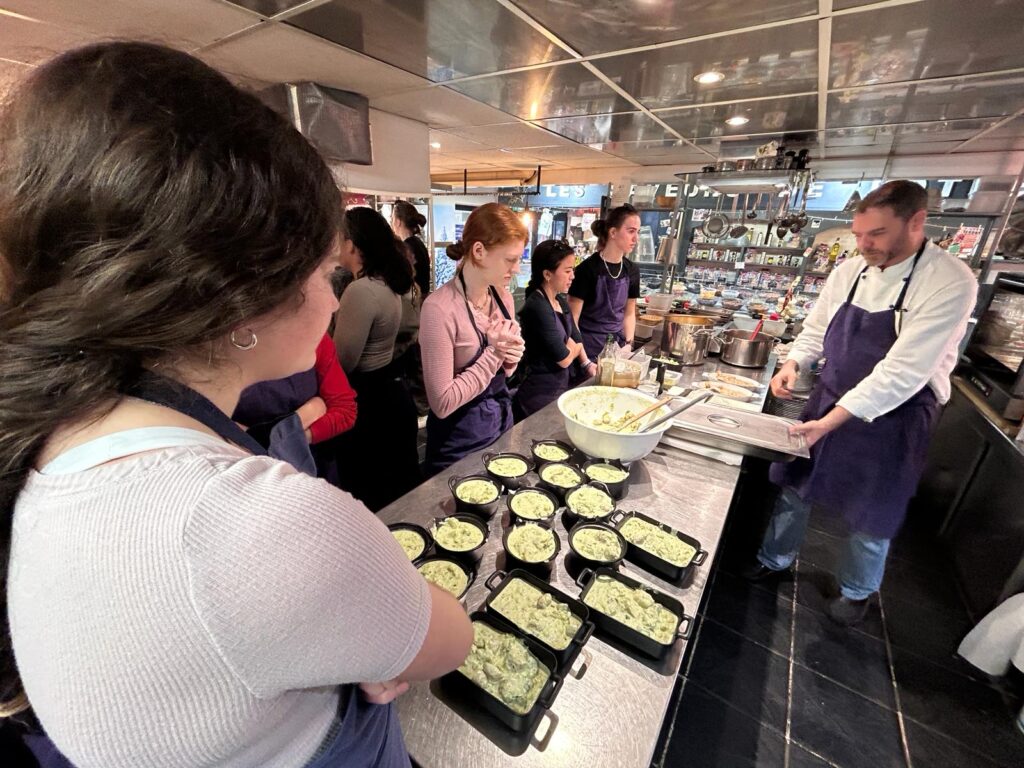
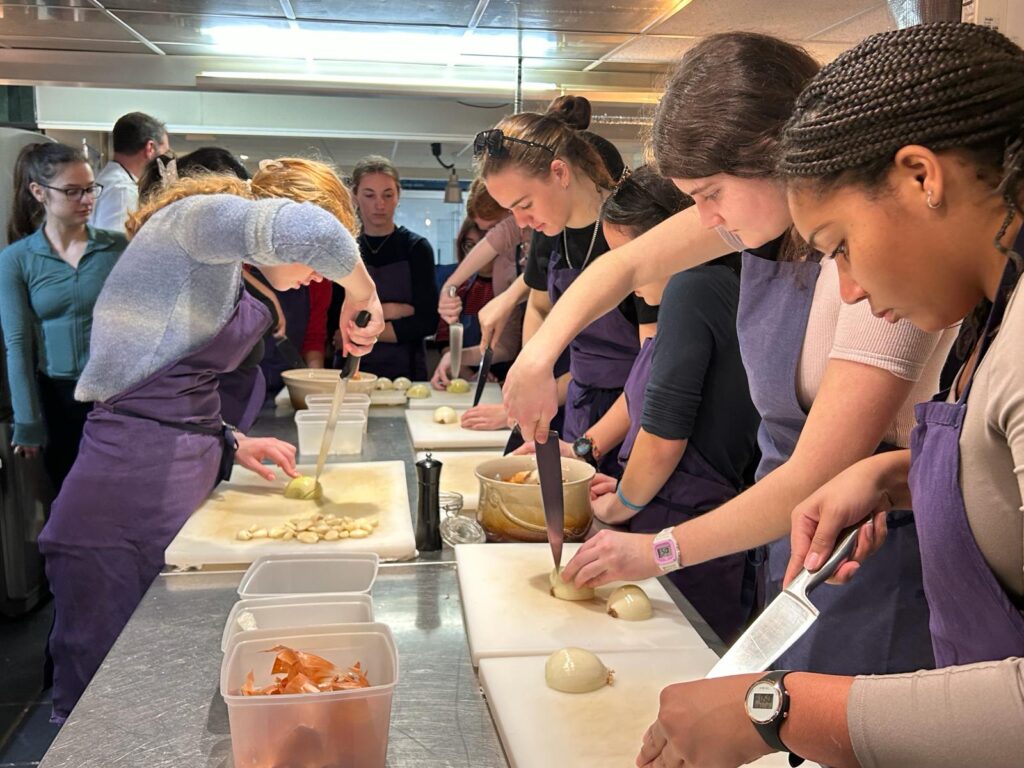
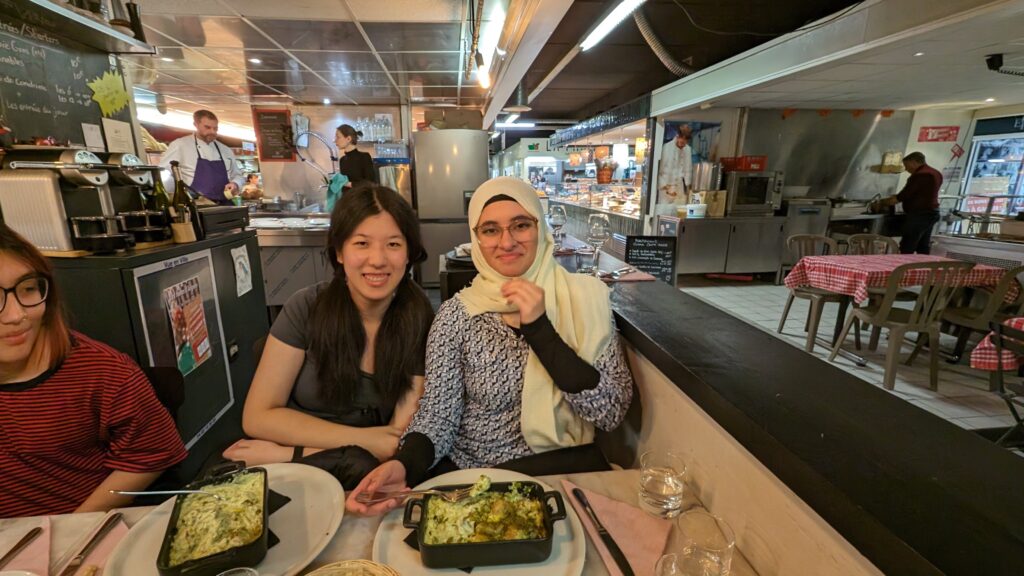
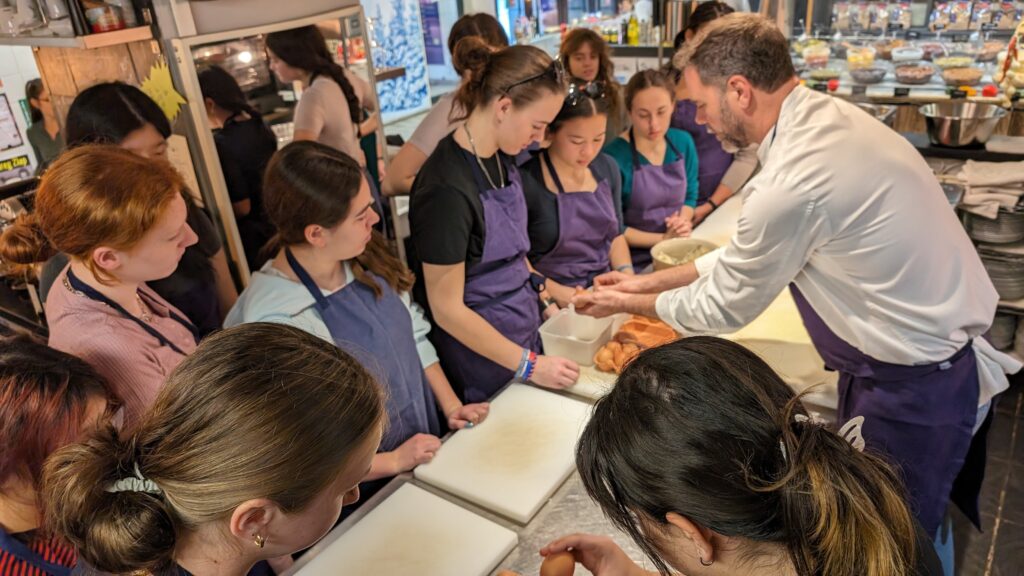
Katherine: After going to the Musée de Petit Palais, we moved on to the Musée Lapidaire. This museum contained many Roman, Greek, and Egyptian artifacts. While the sculptures, sarcophagi and vases were very beautiful, they did bring to mind the colonialism that must have brought some of them to France. We have talked a lot in class about preservation of cultures and communities and I realized that such an important part of culture is its art and history, and it should not be taken from them. While the museums in Avignon are free, there are other countries making money off of artifacts that were stolen. In conclusion, I learned today that retaining and reclaiming historical artifacts is a large part of reviving and preserving cultures in different communities.
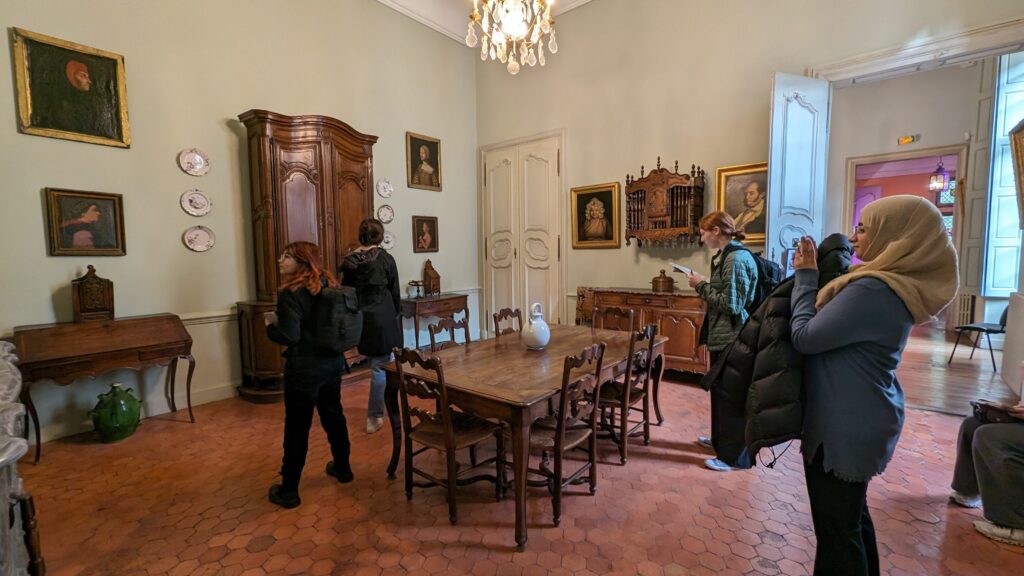
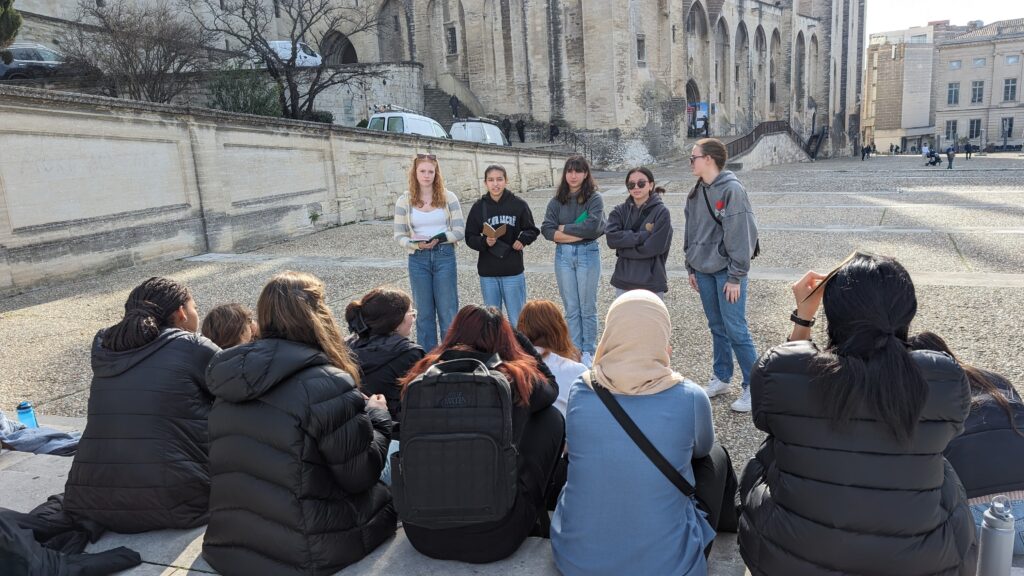
February 7
Student Author: Margaret F.
Margaret chose to share her reflections in French and you will find a translation below.
Bonjour! Cet après-midi, notre groupe a fait un tour d’Avignon avec un guide local, Julien. Car nous avons déjà vu beaucoup de choses, Julien nous disait des infos plus spécifiques sur l’histoire et la culture de la ville.
Quelque chose que j’ai trouvé intéressant était toutes les “Notre Dames” qui protègent les gens dans chaque rue quand ils ne pouvaient pas aller à l’église pendant les pandémies. Ces “notre dames” sont de petites statues de la Vierge qui se trouvent partout dans la ville dans de petites niches dans les rues de la ville. C’était important de reconnaître comment les petites choses peuvent avoir une grande signification.
Une autre chose que j’ai aimé était les recommandations de Julien. Quand nous avons marché sur la ville Julien nous a recommandé un chocolatier, un boulanger et une pâtisserie. Bee, AJ, Fiona et moi avons essayé un croissant de ce pâtissier. C’était délicieux! Finalement, je veux souhaiter bonne chance à l’équipe de ski avec leurs compétitions. Vous me manquez. À bientôt!
Translation:
Hello! This afternoon our group took a tour of Avignon with a local guide, Julien. Since we have already seen a lot of things, Julien told us more specific information on the history and culture of the city.
Something I found interesting was all the “Notre Dames” who protect people on every street when they couldn’t go to church during pandemics. These “notre dames” are small statues of the Virgin Mary that are found throughout the city in small niches in the city streets. It was important to recognize how small things can have large significance.
Another thing I liked was Julien’s recommendations. When we walked through the town Julien recommended a chocolatier, a baker and a pastry shop. Bee, AJ, Fiona and I tried a croissant from this pastry chef. It was delicious! Finally, I want to wish the ski team good luck with their races. I miss you. See you soon!
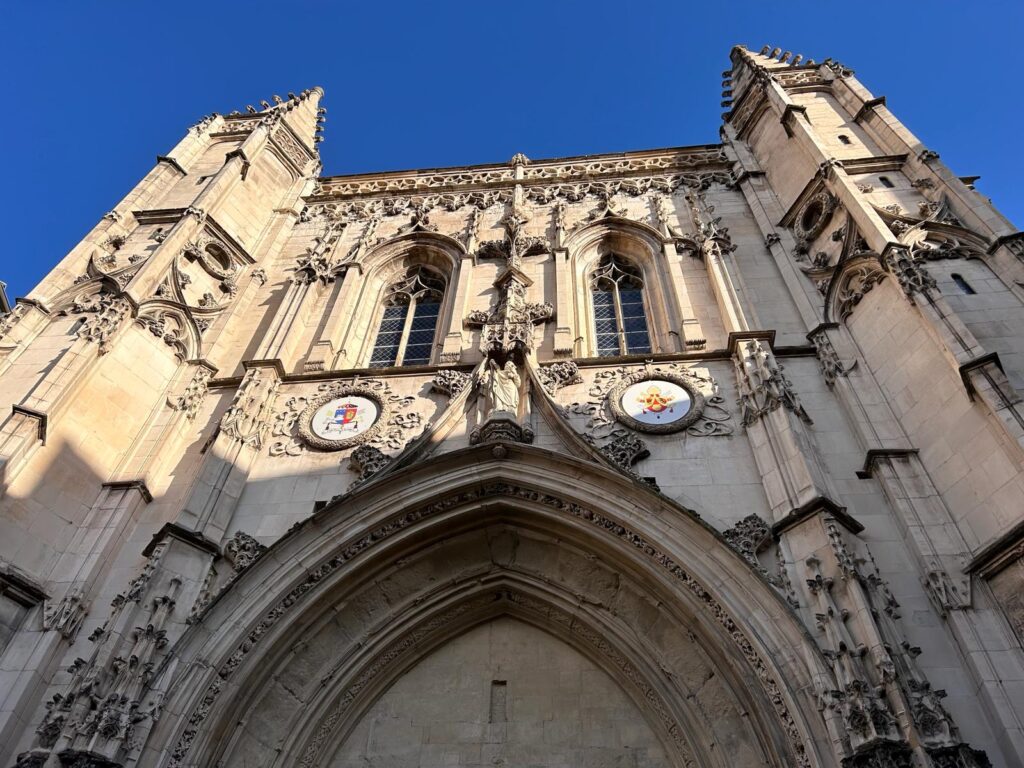
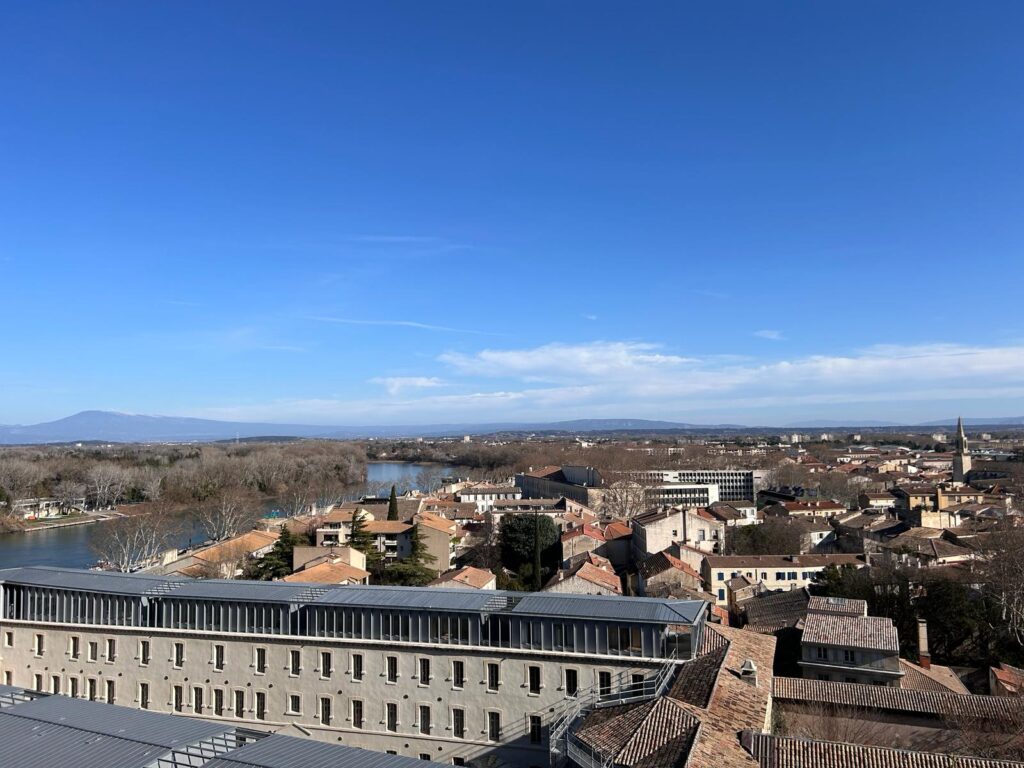
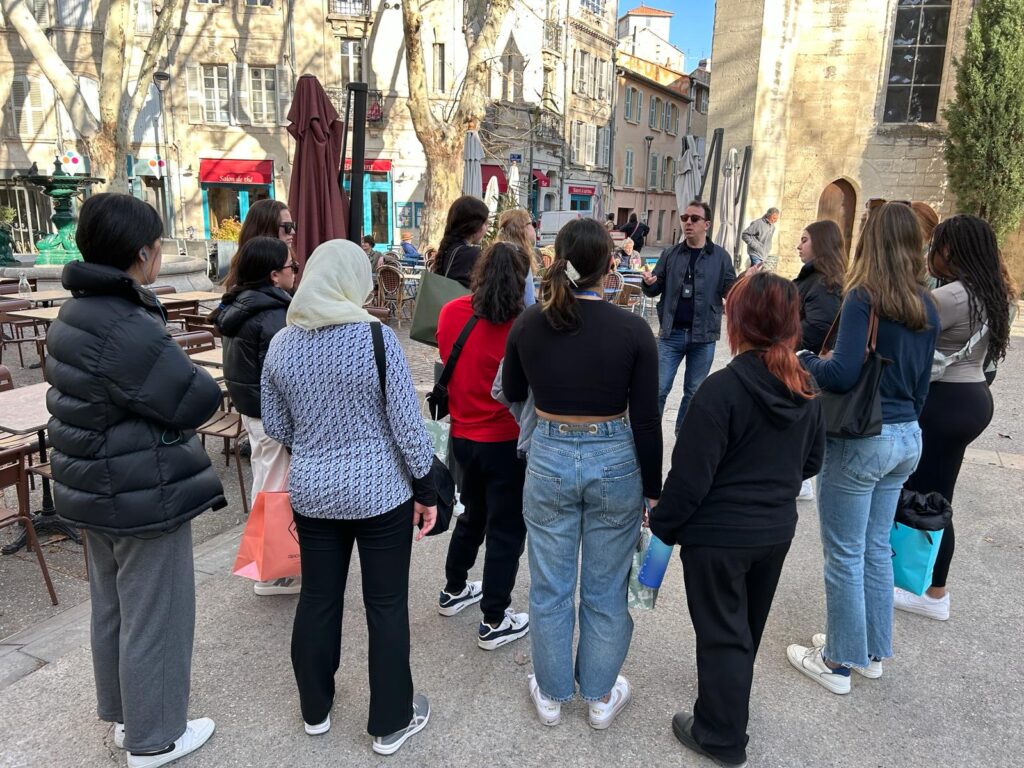
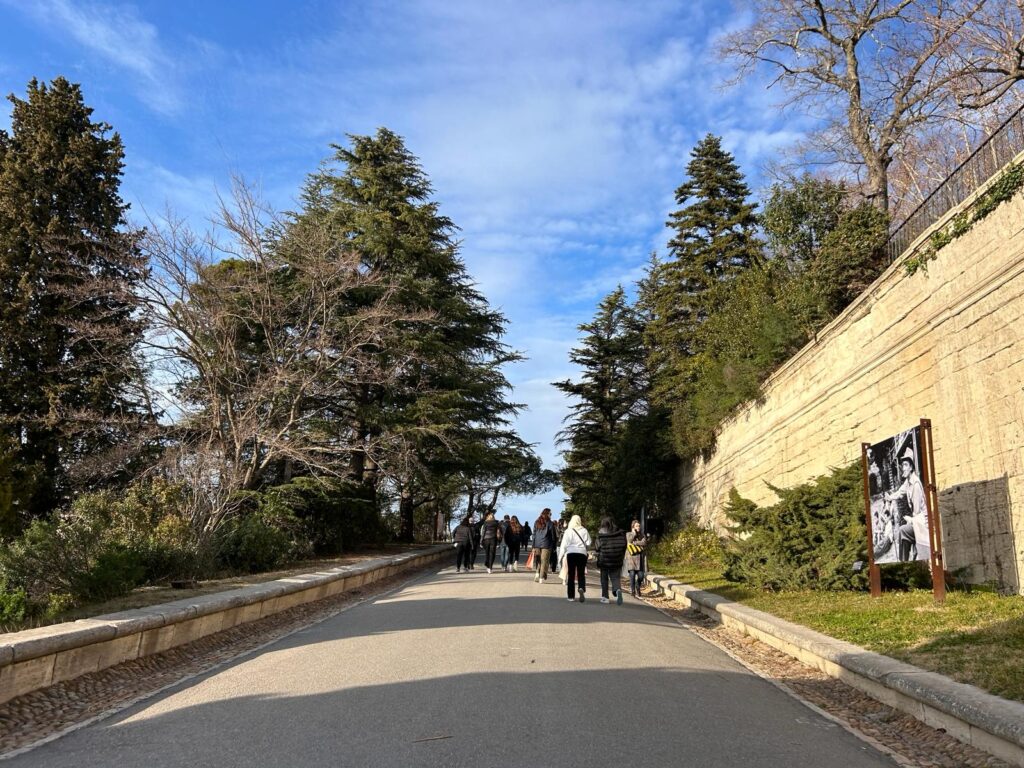
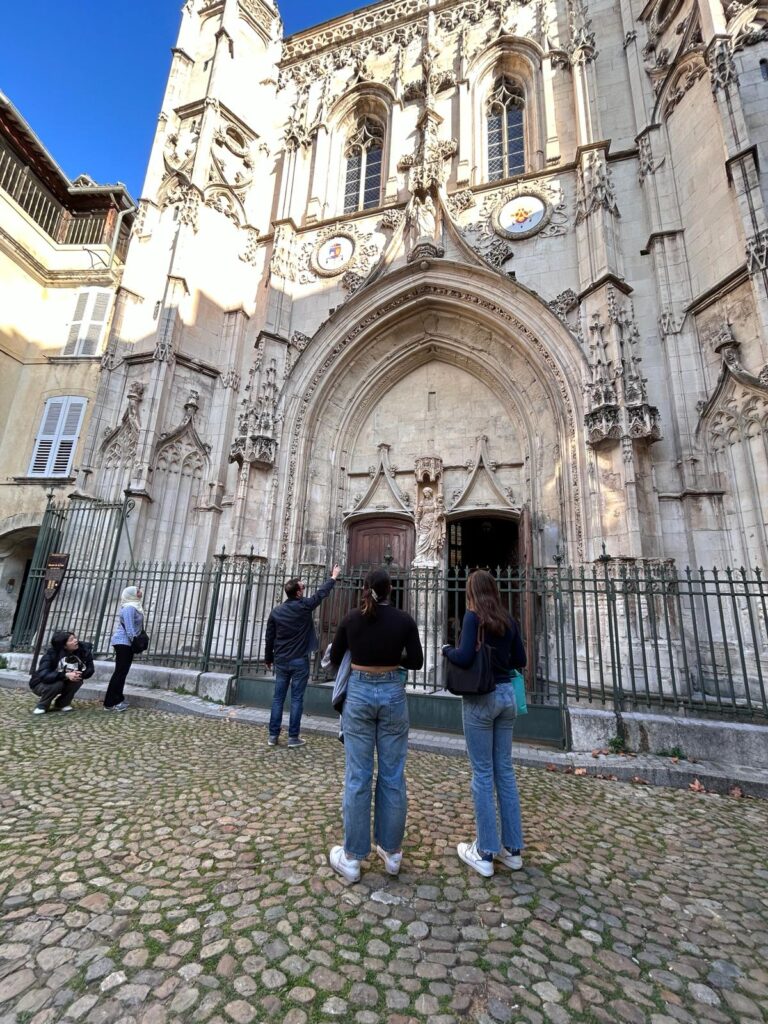
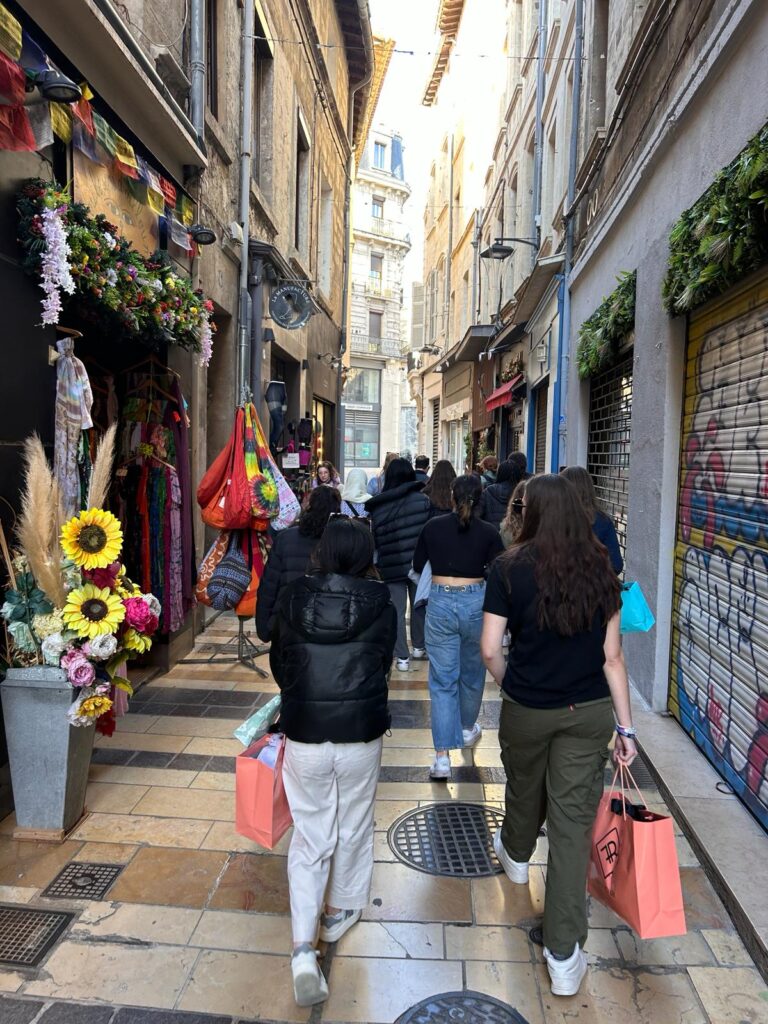
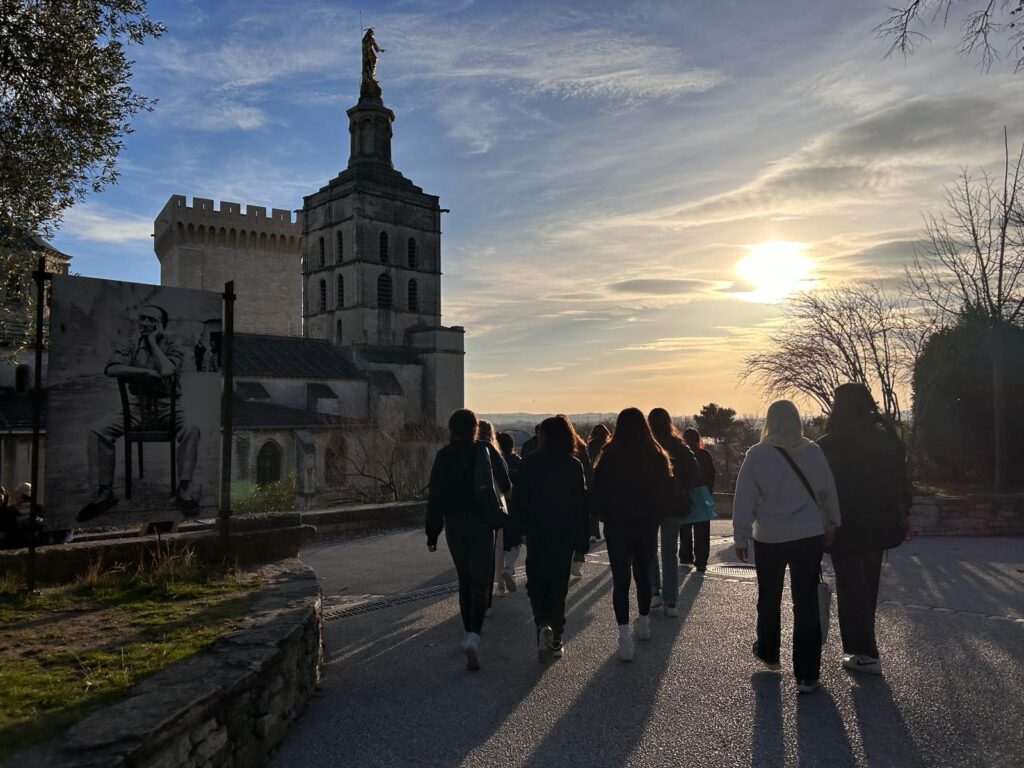
February 6
Student Authors: Nora B., Suri J., Gwen R., and Julia X.
Gwen: When I talked about the trip with family and friends and shared that we would be spending time in Marseille, they were shocked. My peers believed Marseille was a city in ruins and was not a great place to visit. With this in mind, I wasn’t expecting to enjoy the day in the city. However, upon arrival, I was shocked to see how lively and beautiful the city was. As we toured some neighborhoods and learned more about the city’s past, it became clear that I was fed some pretty common misconceptions about Marseille. Later on in the day, I was discussing with my classmates and we agreed that it seems like a cool place to live, with the views of the Mediterranean and the intense culture we saw through its street art. While my view of the city is obviously very limited, my biggest takeaway from this experience is that stereotypes aren’t always accurate and you should leave your opinion up to your own personal experience.
Nora: This morning our group met Olivier, a local urban planner and cartographer, born and raised in Marseille. He took us on a walking tour of the city. We were able to hear about the history and revival of Marseille. He explained that in the 70’s Marseille became overtaken by the mafia. This brought in a lot of crime while also bringing down the reputation of Marseille. In following years, however, not only was there a revival of Marseille, but a coming together of the community. When we studied Hartford in this AIS class, we have also seen a similar “falling” of a city. What was once active and bustling would be now considered empty. While the deterioration of these two cities was caused by different reasons, I think the solutions can be similar. We learned that the community in Marseille is their strongest asset. In many of the small old, traditional neighborhoods they are not ruled so much by what the actual local government says but by what they agree on as a community.
Marseille has been able to resolve many of their issues and do a full 180. I look forward to coming back and learning more about how Marseille was able to revitalize their city and how Hartford can do the same. I am glad to see how what we learned in class is connected to what we are seeing in real life.
We enjoyed the beautiful views and stories of Marseille. It was definitely one of my favorite days so far. The food today was also amazing!
Suri + Julia: Our favorite part of the day, how was a tour with Mahn Kloix, a Marseille-based street artist. He took us around Marseille and showed us his murals drawn on buildings (and we also got to see his studio!). Julia’s favorite part was being able to hear the stories and the meanings behind each of Mahn’s pieces of art, because we don’t often get the chance to hear from the artists themselves. I thought this was cool as well. My favorite piece of his was one of his smaller pieces, part of a larger project of “fragments.” This piece depicted a father and son, and Mahn explained it was about migrants and their family relationship, but outsiders were free to interpret however they saw.
We were very inspired by Mahn and thought he was very cool, this was the peak of our day!!
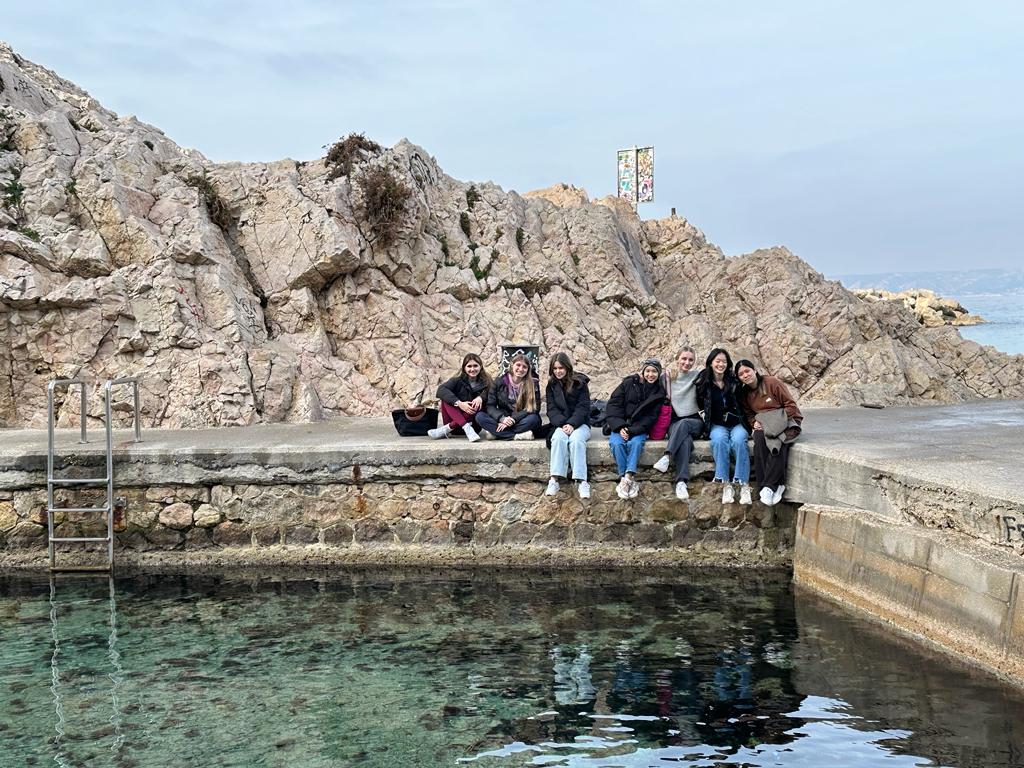
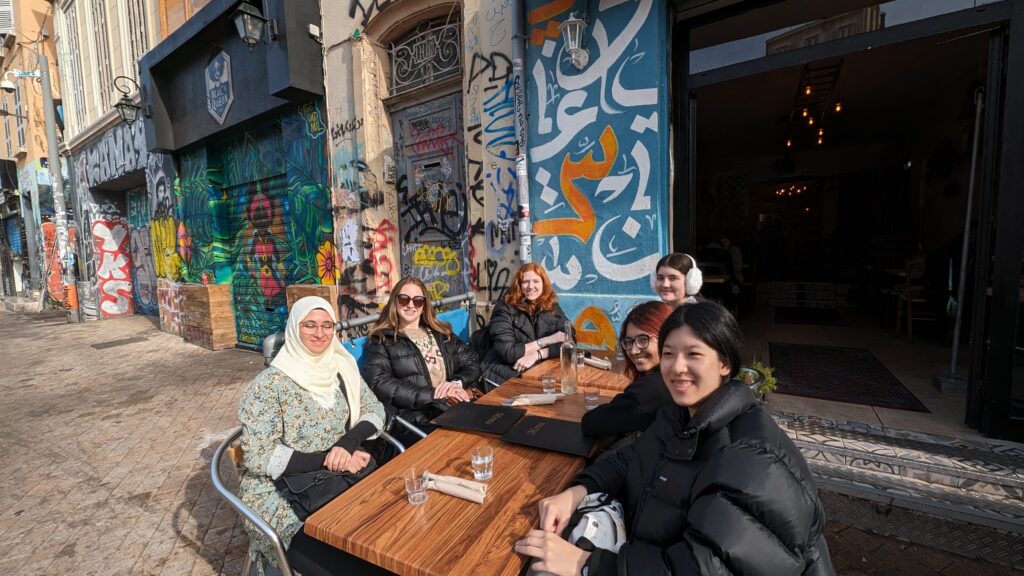
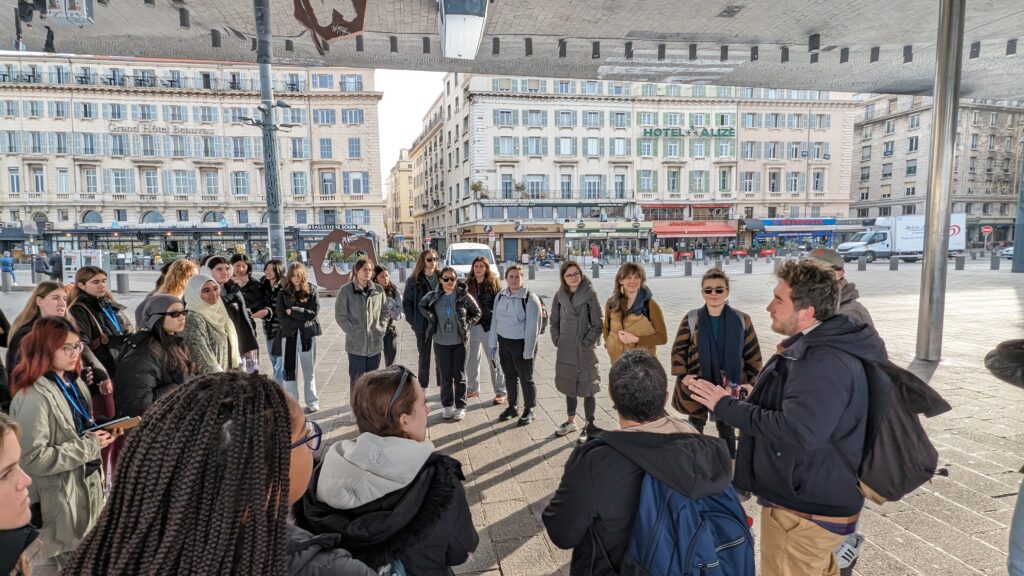
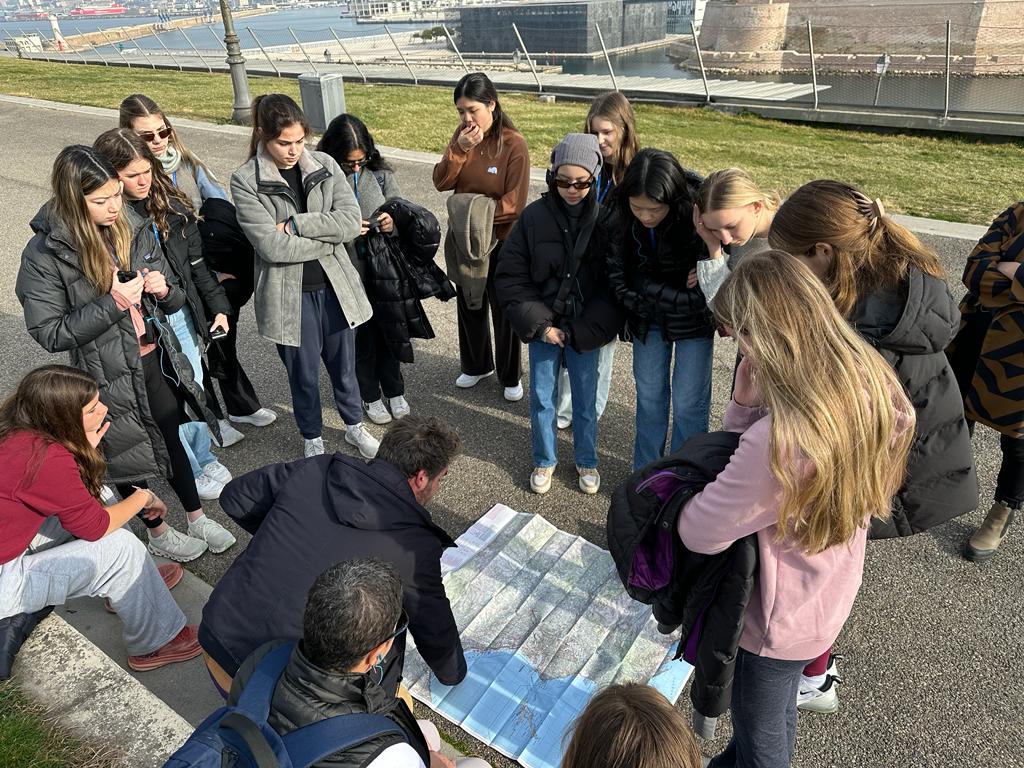
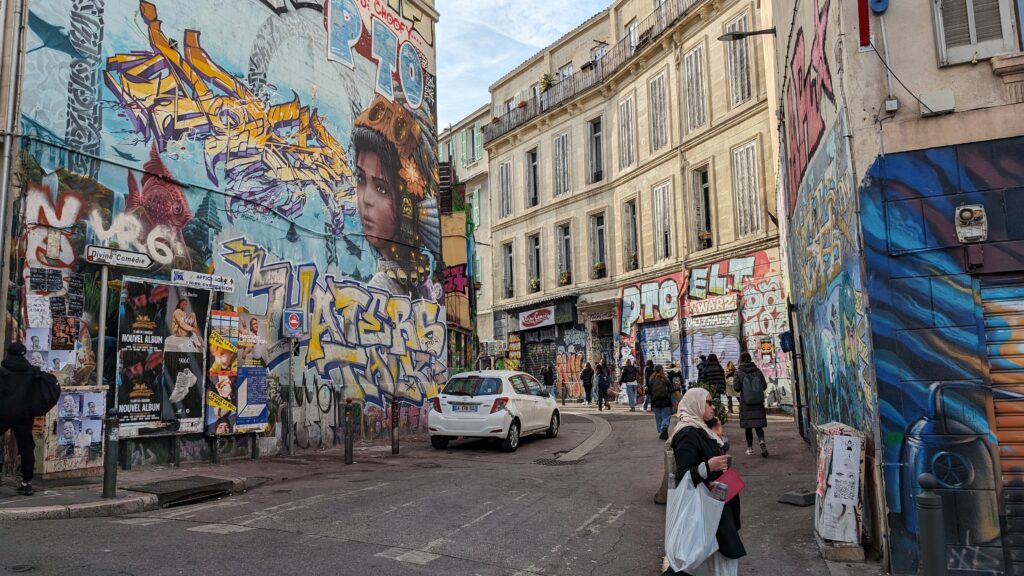
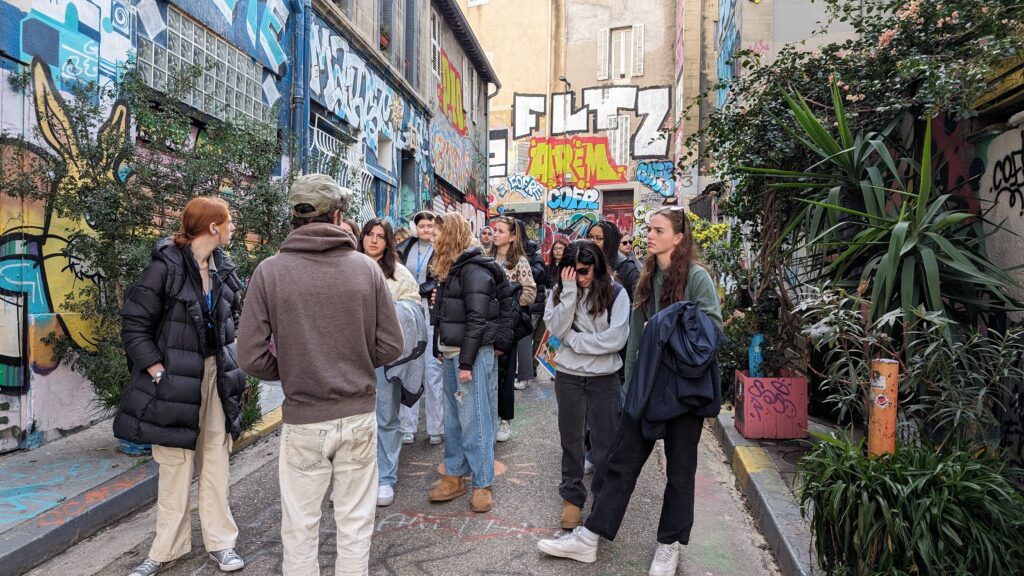
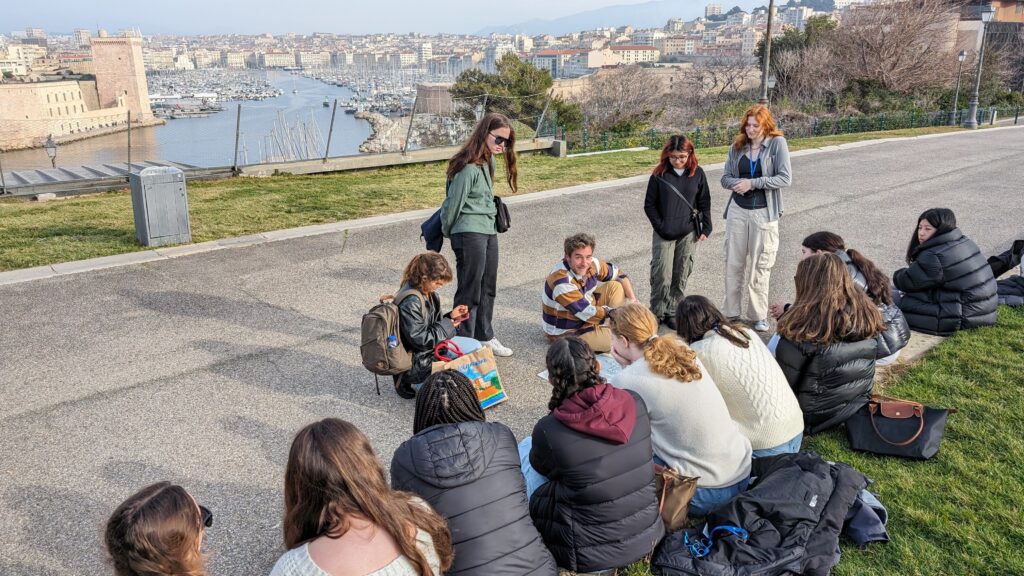
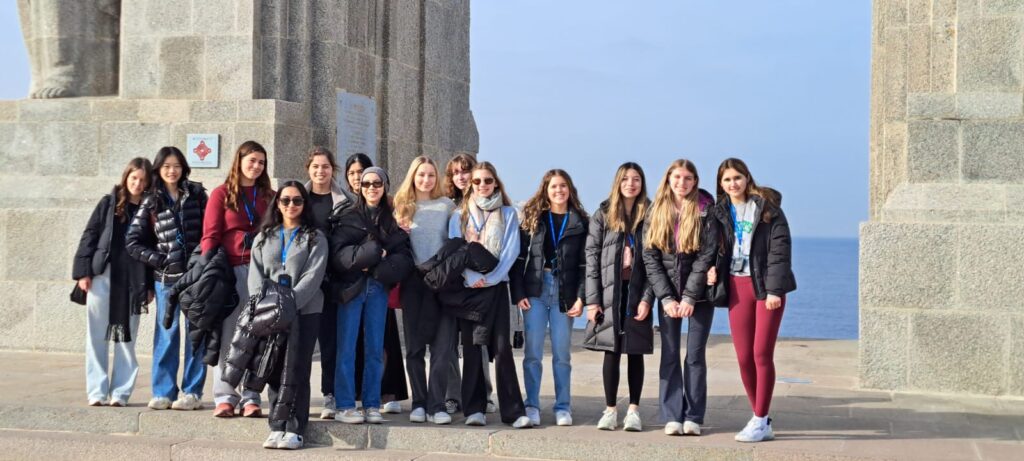
February 5
Student Authors: Sam O. and Bella S.
The day began with our customary delicious breakfast at our hotel. Croissants, jam, coffee… a perfect way to start the day. Our first activity today was an urban sketching workshop. We spent the morning drawing out scenic places including bridges, churches and gardens. It was a time of decompression and self-reflection, making it a perfect activity for the beautiful warm weather.
After drawing, we ate lunch at Café Saint-Jean with the rest of the group. Sam ate a French-style cheeseburger with potatoes, and Bella had linguini pasta with mushroom sauce. It was excellent.
After lunch, we took a tour of the Palace of the Popes, and were able to see a whole view of the city. We learned about France’s history, and its connection to Italy in the Middle Ages, both through the Popes and in the arts.
After the tour, we had free time. Sam went shopping and Bella went back to the hotel to rest. After a wonderfully spent afternoon, we had a DIY dinner and split into different groups to choose our own restaurants in the Place Pie area. Despite being in different dinner groups, we still ended up both going to the Café Saint-Jean to eat, and we liked it again.
Following that, we walked as a group back to the hotel for a late-night recap of our day.
Bonsoir!
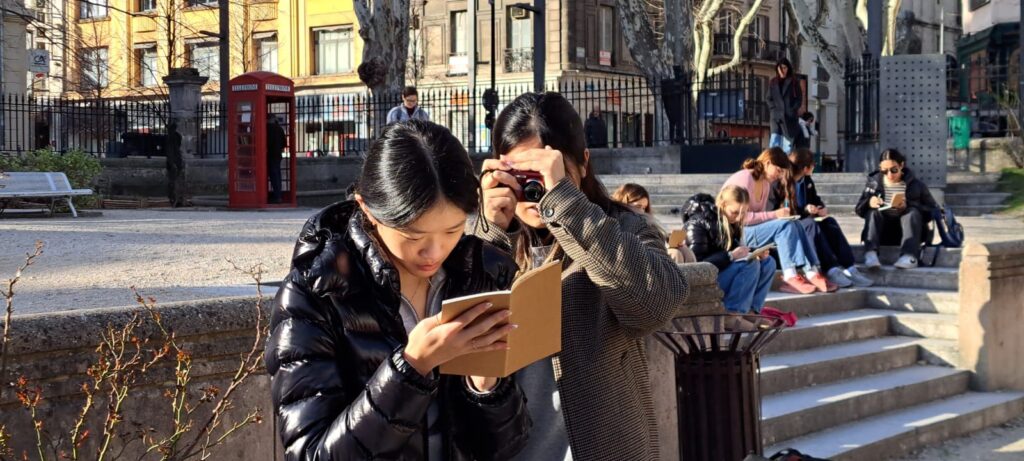
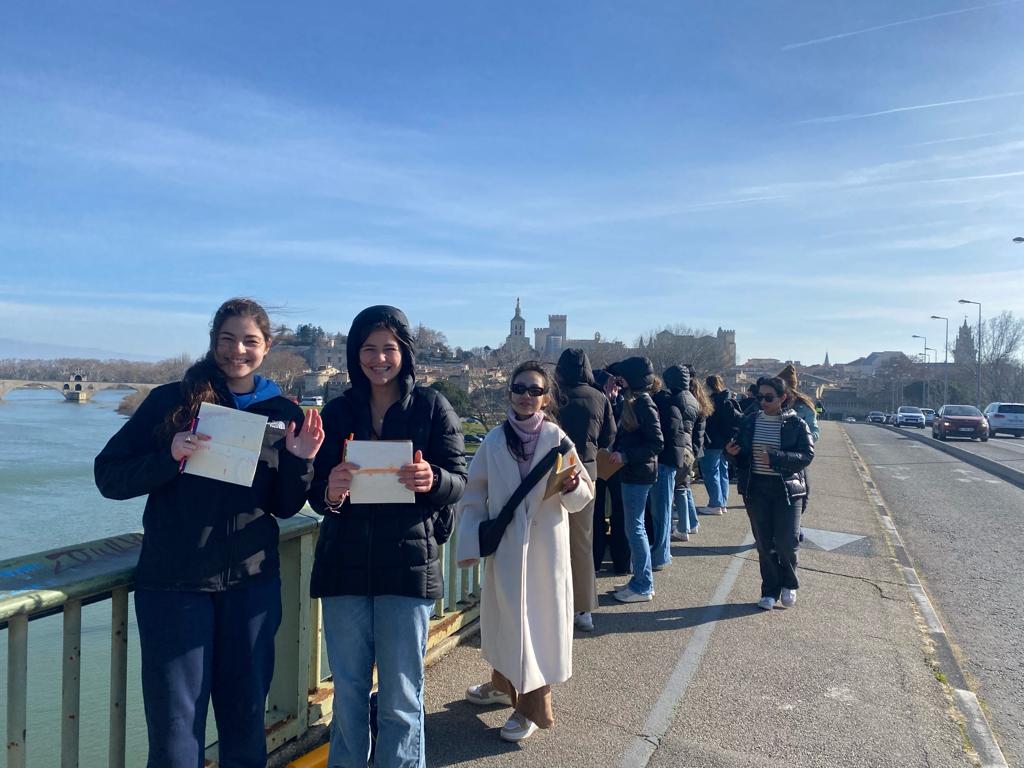
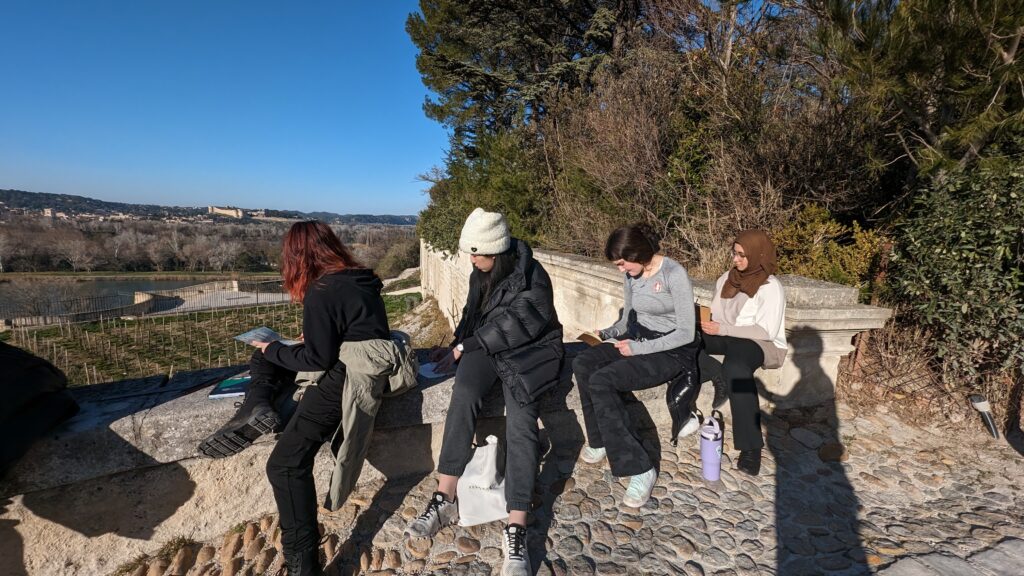
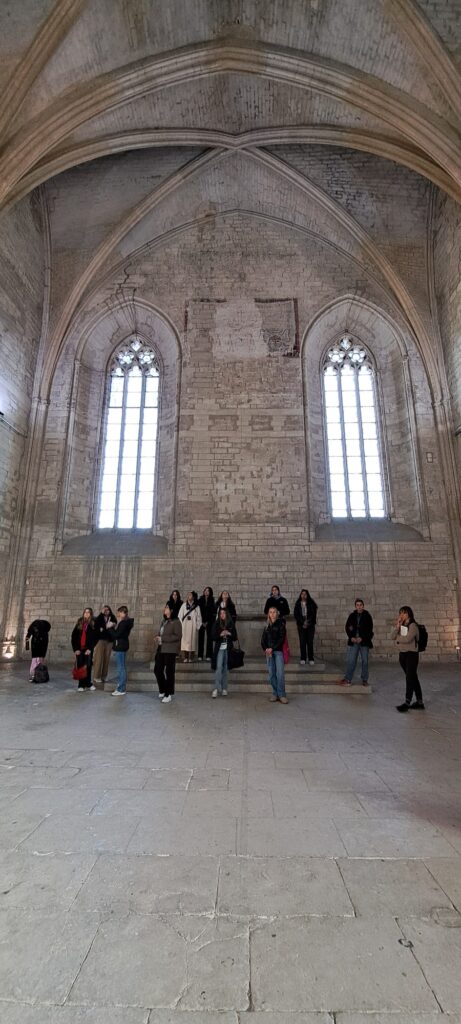
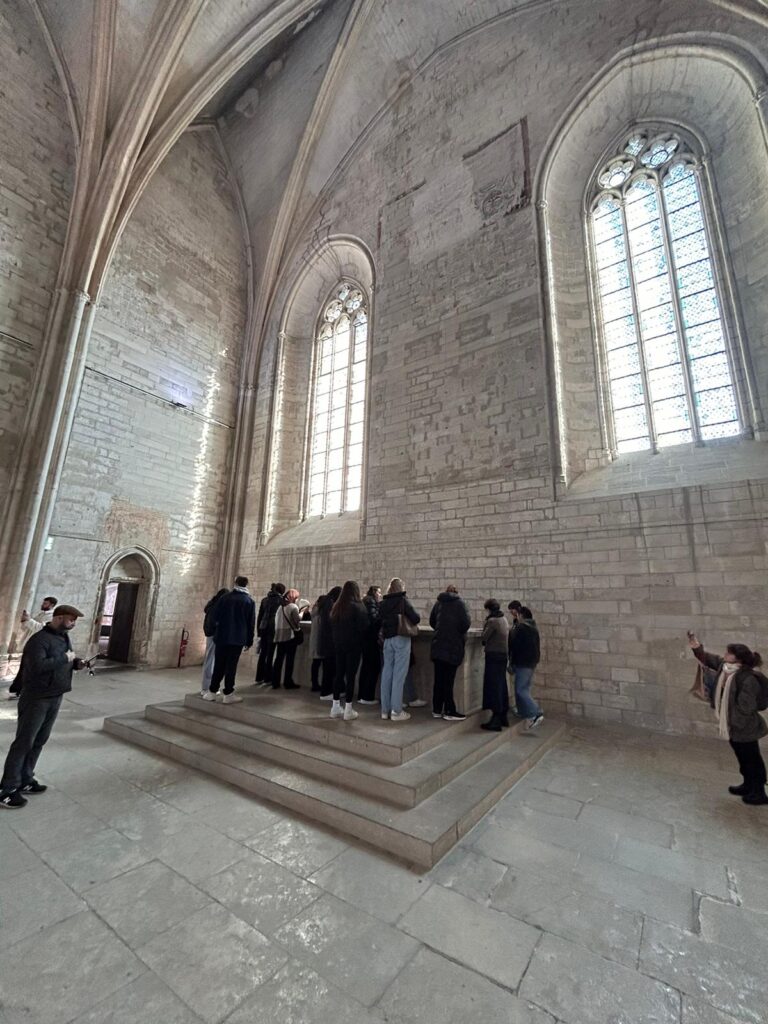
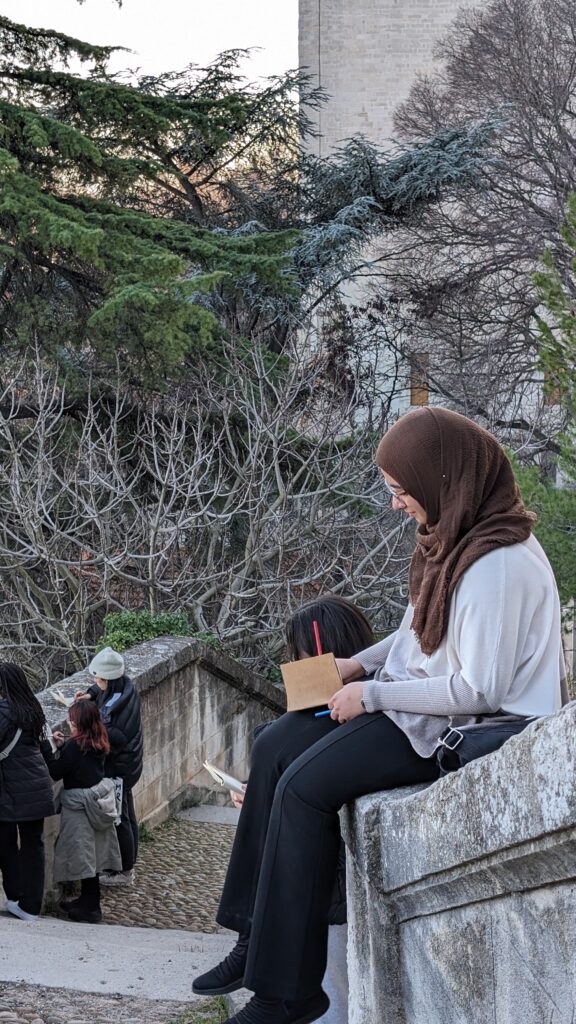
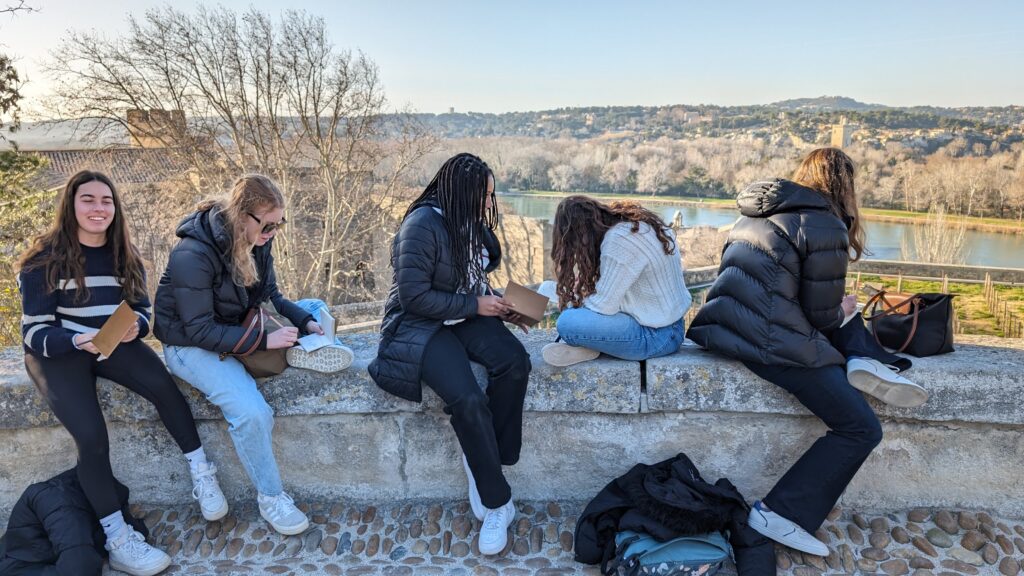
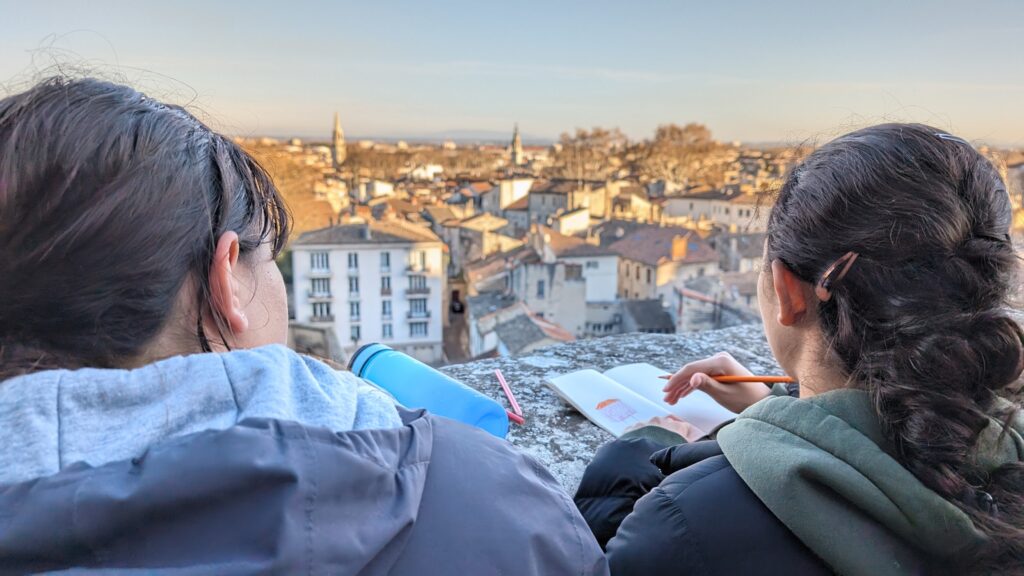
February 4
Student Authors: Maryam A. and Elaine R.
Today, we had a very yummy first breakfast in Avignon, consisting, among other things, of croissants and a lot of tea with lavender honey.
Afterward we had our orientation for the program, which happened at a pizza restaurant, and we also ate lunch there. During the orientation we set some rules and safety expectations for our time here, and we also played a game called “hee ha ho” – it was intense.
Then we went to the Pont d’Avignon. We walked across the bridge, Maryam had the best time there. We split up into small groups and our group went first on an “un-scavenger hunt” (it’s when you go around the city and set up a scavenger hunt for others), we worked efficiently and had time to eat some gelato (YAY 😄)! We switched groups next and discussed about what makes a city a city, and some features of cities.
After an hour of rest at the hotel and listening to some music, we had a delicious meal at a Moroccan restaurant. For appetizers we had the best hummus ever with salad. Then we had couscous with chicken and vegetable broth. For dessert, we had Moroccan pie with rose water.
We then went back to the lovely hotel and got some well deserved rest.
Au revoir!
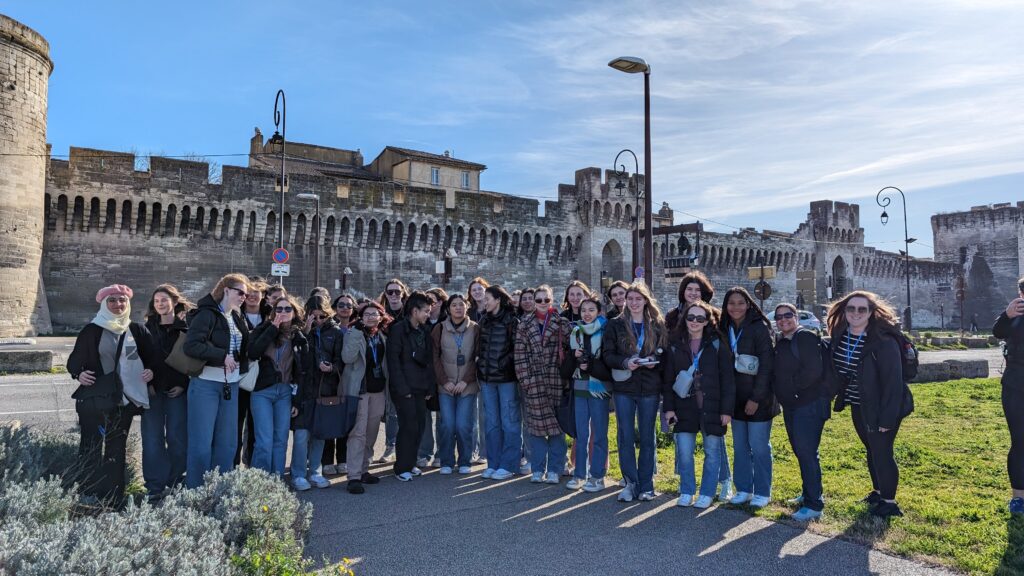
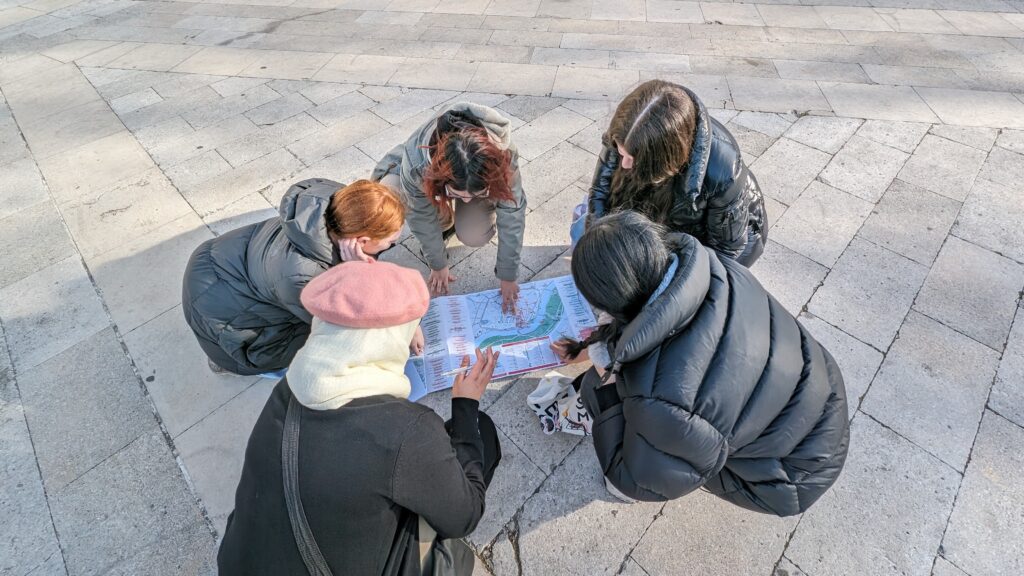
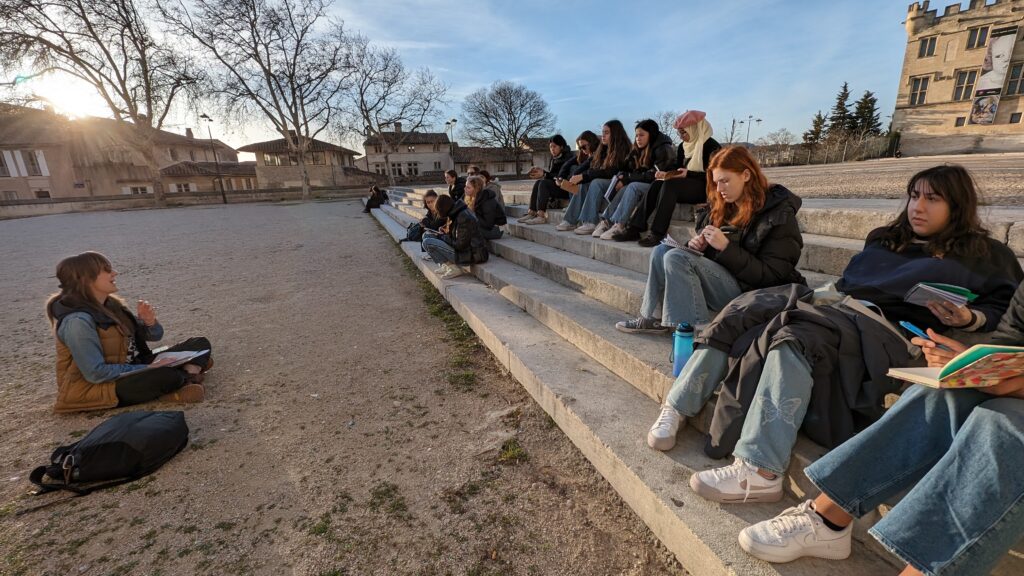
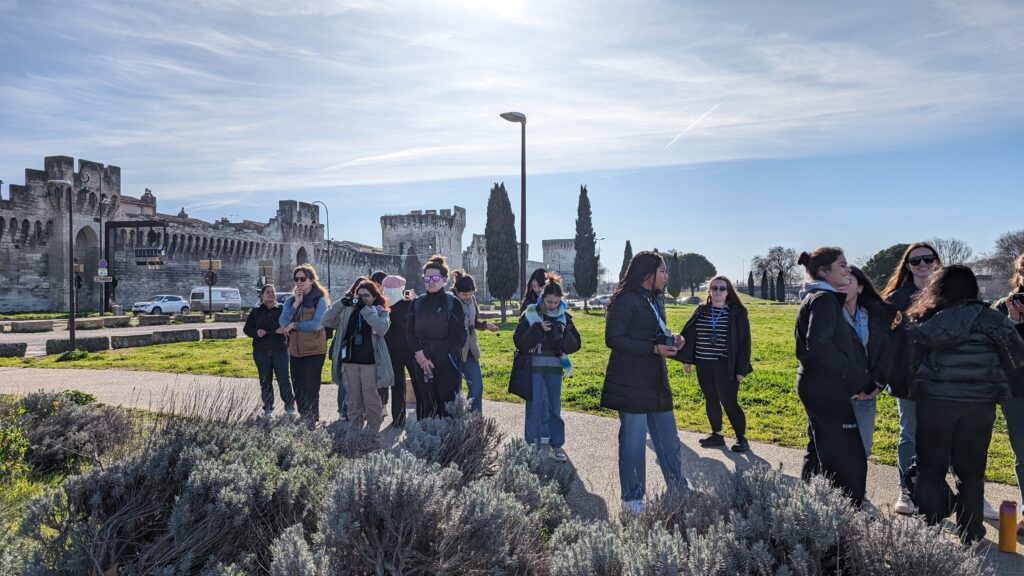
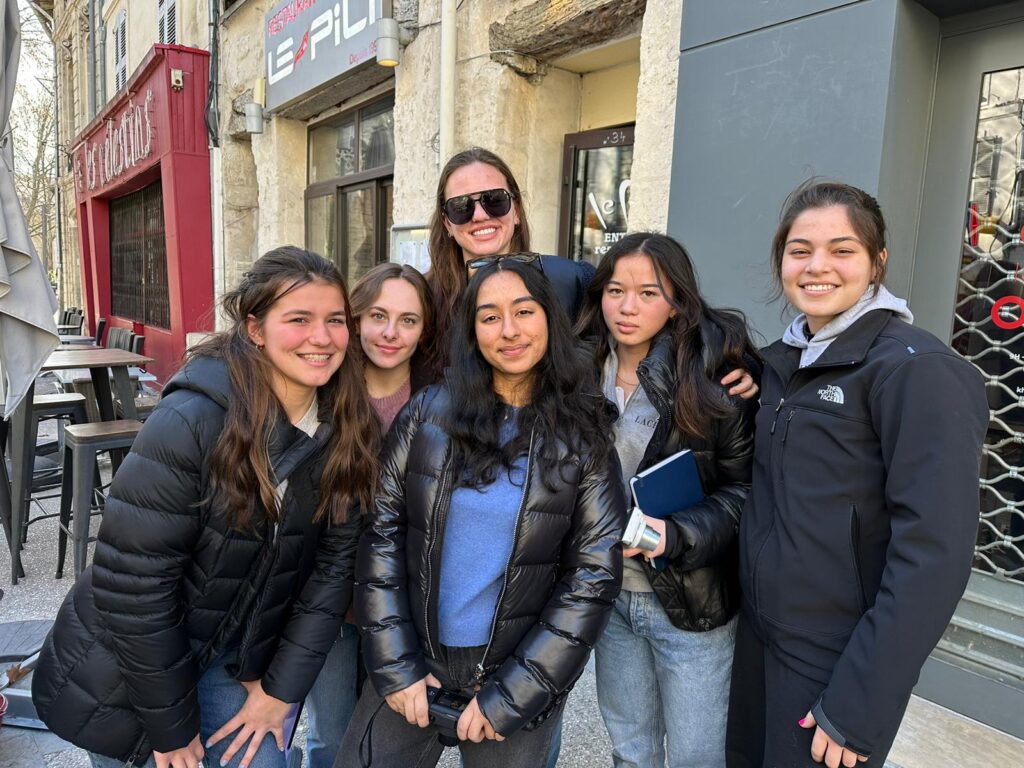
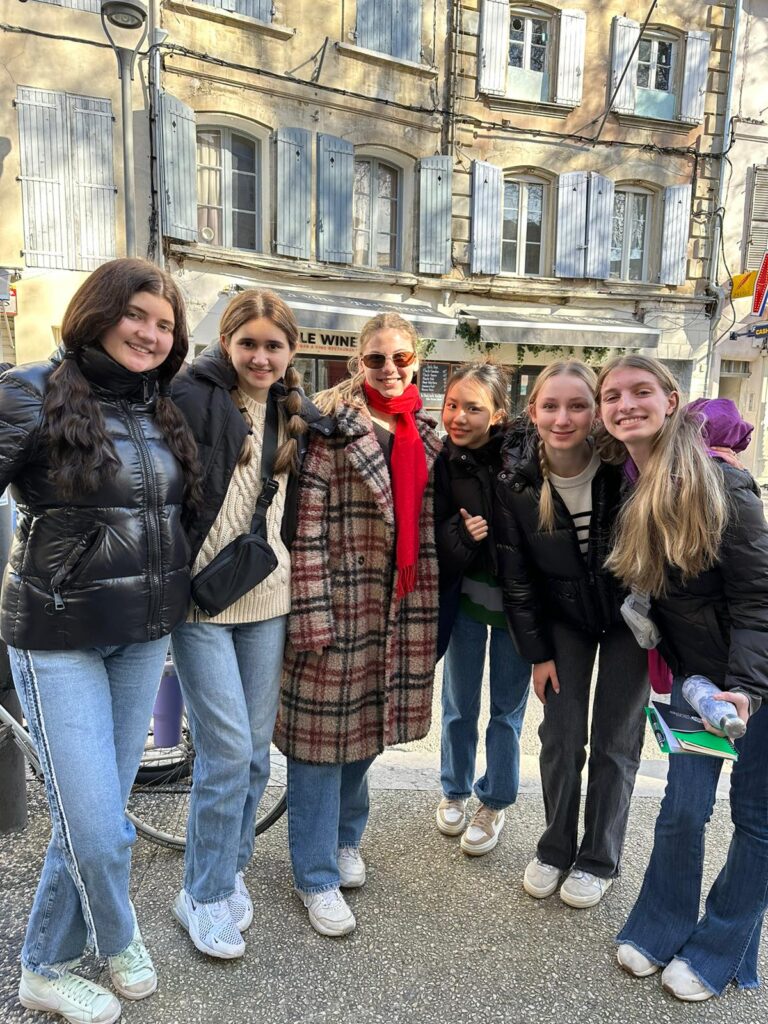
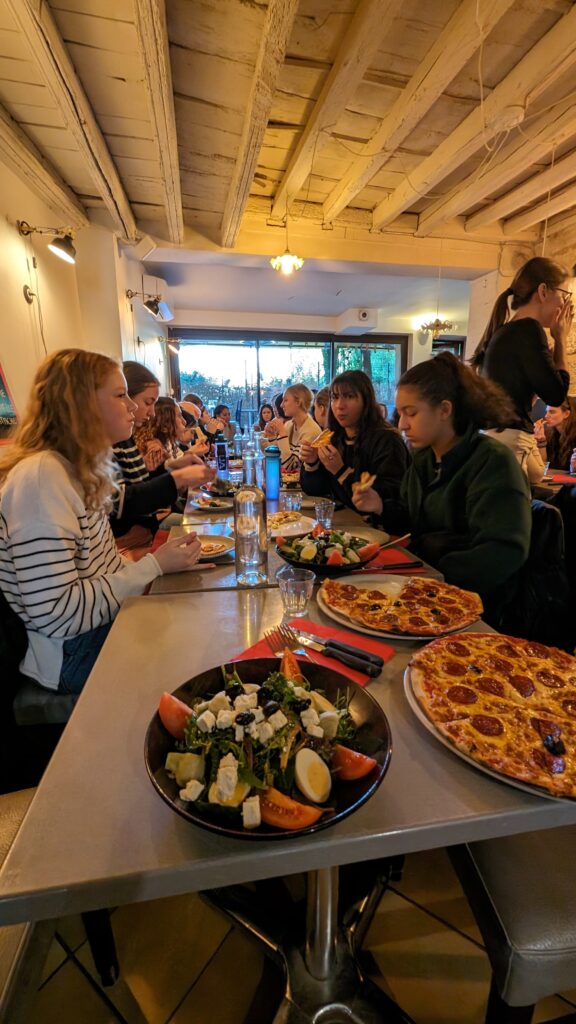
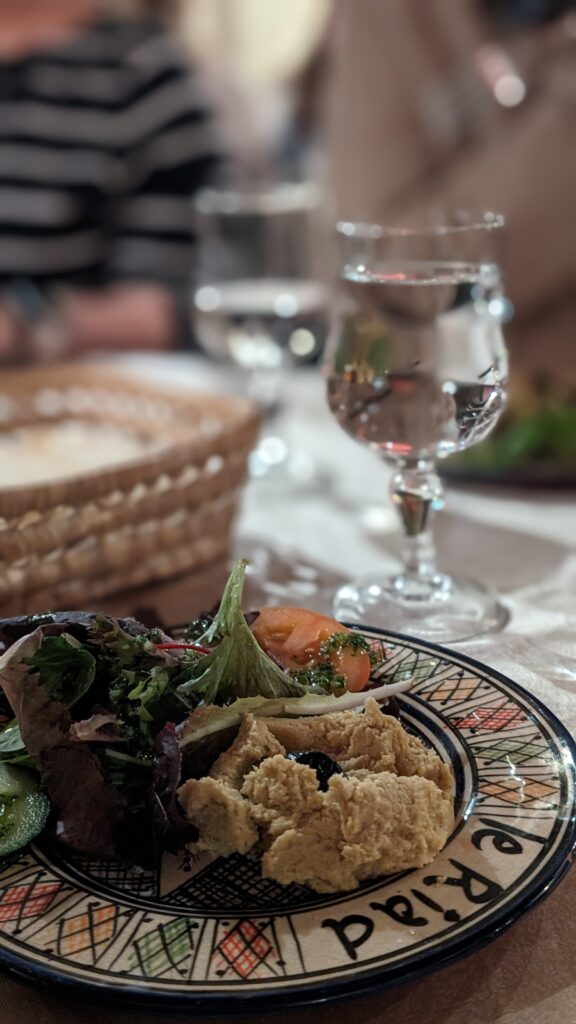
February 3
Student Authors: Kat C. and Katie D.
We landed in Marseille around 2 pm, greeted with warm weather and sunshine. Our tour guides brought us fruit and pastries to enjoy before our bus ride to Avignon. Once arriving in Avignon, we checked into our hotel and began exploring the city.
Going on a silent walk with our groups, we were able to appreciate the sights and sounds of the old city. Our last stop for the night was dinner at Brasserie du Théâtre where we were served a traditional French dish of beef stew with mixed vegetables and warm bread. During dinner, we talked about our initial thoughts of our journey over warm homemade chocolate lava cake served with vanilla ice cream.
We ended the day with a debrief in our travel groups about our first appreciations of Avignon, ranging from our welcoming tour guides to the delish food. We are tired tonight and ready to go to bed, and excited to continue our trip.
